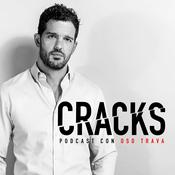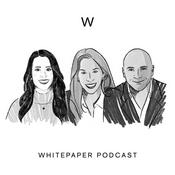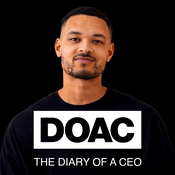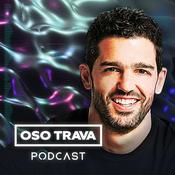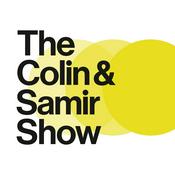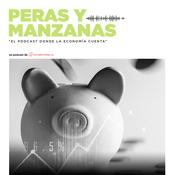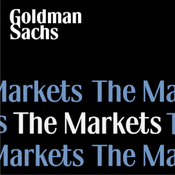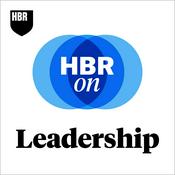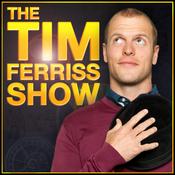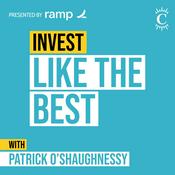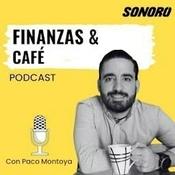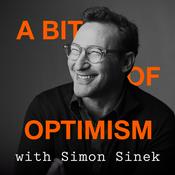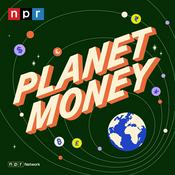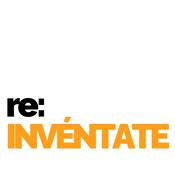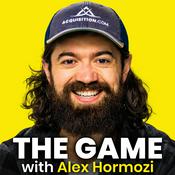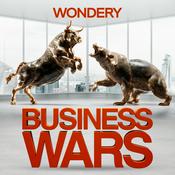47 episodios
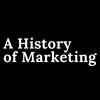
Kevin Lane Keller: The Blueprint for Brand Resonance
18/12/2025 | 44 min
A History of Marketing / Episode 43 If you studied marketing in school, you likely carried Kevin Lane Keller’s work in your backpack.He co-authored Marketing Management, the all-time best-selling marketing textbook, alongside Philip Kotler. And with Strategic Brand Management, Kevin he defined how a generation of marketers understands brand equity. As a Professor at Dartmouth’s Tuck School of Business, he has spent decades bridging the gap between rigorous academic theory and elite corporate practice. He’s consulted for giants like Disney, Nike, and Ford, but perhaps his most interesting “field research” came from working with the Australian rock band, The Church.This conversation is a rare treat for our listeners. Despite his massive impact and the high regard of his peers, Kevin keeps a relatively low profile and seldom sits for deep-dive, long-form interviews. This episode offers unique insights from one of the primary minds to shape modern marketing.Listen to the podcast: Spotify / Apple PodcastsIn our conversation, we discuss:* The P&G Playbook: How he helped transform Pampers by connecting functional technology to emotional “brand mantras.”* The Art & Science: Why great branding requires both a philosophical “philosophy of consumption” and disciplined data tools.* Managing The Church: What he learned about marketing, fan engagement, and “continuity vs. change” while managing a legendary Australian rock band.Now, here is my conversation with Kevin Lane Keller.Thank you to Xiaoying Feng, a Marketing Ph.D. Candidate at Syracuse, who volunteers to review and edit transcripts for accuracy and clarity.Collaborating with Kotler on “Marketing Management”Andrew Mitrak: Kevin Lane Keller, welcome to A History of Marketing.Kevin Lane Keller: Thanks for having me.Andrew Mitrak: I’m so excited for this conversation because like a lot of people, Marketing Management was my textbook in grad school, and your name was on the cover there right alongside Philip Kotler’s. So, how did you get involved with becoming Philip Kotler’s co-author?Kevin Lane Keller: It’s interesting. I actually used the textbook too when I got my MBA. I had the third edition, so it’s going back a ways. I think it was the fall of 1978. I have enormous respect and he is a legend, but was a legend back then when I was taking the course. But I had the chance to publish my own textbook on Strategic Brand Management. I had done that and that was really my area of interest, but I’ve always been a marketer at heart in a very broad sense. So the publisher was looking for someone to be a co-author, and because of my experience and some of the things I was interested in, it seemed like a nice fit. So I actually did the 11th edition. Phil and I worked together just to sort of try it out, kind of both sides, and it went well. I enjoyed it a lot. And so I think it made sense and starting with the 12th edition I was formally the co-author and have been a co-author ever since.Andrew Mitrak: When you write a book like that, that is so widely read and is sort of the Bible for a lot of folks who are just getting into marketing—if a professional marketer reads one book, that’s often the one that they reference—is there a lot of pressure when you write a book like that to make sure it’s accurate and up to date? Do the stakes seem very high for it?Kevin Lane Keller: It’s daunting. When you think about it, it’s an impossible task because you’re trying to capture all the richness and all the detail and manage to distill that down and package it and write it and source it and reference it and everything, and make it engaging and interesting. So it is difficult. I enjoyed doing that. I think the challenge of that. And you break it down. It’s a little bit like building a house. You think, “Oh my God, building a house.” Well, you’re doing rooms and within rooms there are certain things you have to do. So you really break it down. It is very modular in how to approach it. But the big challenge is really keeping it up to date and making sure that it captures what modern marketing is and, more importantly, maybe what it should be.The Challenge of Keeping Marketing Texts RelevantAndrew Mitrak: Yeah, I have a question around keeping it up to date because there are probably certain core principles that you want to keep tried and true. Things like segmentation, targeting, and positioning, I think, were in my version of the book. I’m sure the Four Ps were referenced in it and things like that. But then there are a lot of things that change. So how do you think about what changes versus what doesn’t change?Kevin Lane Keller: I think there is always continuity and change in marketing in general. I’ve worked with a lot of brands, I’ve worked with a lot of legacy brands, really strong brands, and that’s always the challenge: how do I move forward, but how do I move forward in the right direction and in the right way, at the right pace and all of that. It’s no different with a textbook. You are thinking about what are the new ideas and the new concepts. And sometimes new frameworks and new ways to organize and think about things. But yet at the same time, there are those core principles and segmentation and targeting in some sense, and positioning in some sense. It may change some how you think about those, but that notion and those concepts themselves at least at a high level are ones that are retained. But a lot of things change and especially with digital and with AI, we’re really trying to make sure the book reflects that.Andrew Mitrak: Yeah, I was thinking just about that example exactly. Like I’m sure SEO is covered in a book, right? It’s a very big thing. But then even the language around it is changing. Sometimes it’s called Answer Engine Optimization with an AI. Sometimes called Generative Engine Optimization, GEO or AEO with AIs. And then it’s sort of just you might just call it LLMs. And the language itself, especially at this moment when we’re recording here in November 2025, is changing so much where if you committed to something in a book very quickly it could be outdated. If that version is used for years, it could just wind up being a thing where you’re like, “Ah, kind of missed the boat on that one.” So how do you sort of think about staying relevant without becoming outdated too much?Kevin Lane Keller: Well, I think you think about updating more frequently. I think that is probably one of the answers because there is nothing you can do. You can only go and be as current as you can till literally the moment of publication. So you’re always having the final proofs and you’re looking at them and you’re literally making changes and edits to try to make sure everything is as up to date as possible at that point in time. But at that point in time, then you move on in some sense. It is a little more dynamic with publishing. You have more opportunities to do updates and bring that in. So that’s the advantage of the e-text and the more digital versions versus the hard copy, the kind of classic textbook version in that sense. But you are always trying to. And look, the AI, that is an area that is just exploding so much and changing so much that it’s going to be a moving target for a while.Andrew Mitrak: Oh yeah, keeps it interesting.Kevin Lane Keller: Yeah, it does. Yes.Collaborating with a Marketing LegendAndrew Mitrak: So what was it like collaborating with Phil Kotler?Kevin Lane Keller: I had known him some through the years. He had actually tried to recruit me as a PhD student to Kellogg at one point in time, wrote a very nice letter when I was just first getting my PhD and through the years. He’s one of these guys. I joked when they had at one point an event to kind of honor Phil at Kellogg at Northwestern, and I joked that there had to be like three Philip Kotlers and we only actually had one of them in the room and the others were busy doing all the other things that Phil Kotler does because he’s just remarkably productive. I mean, unbelievably so. And the way he gets things done. But he’s the nicest guy. His ability, his radar to pick up on what matters. His ability to synthesize that, clarify it, put it into context. It’s just amazing. So for me, I’ve learned so much, which is great. But I’ve also enjoyed it so much. So he’s made it fun. So it’s just been great. And he’s still heavily involved with the book. So he definitely is still providing a lot of input, a lot of feedback. So he’s definitely part of the book still.Andrew Mitrak: That’s amazing. Even into his mid-nineties. I think because he was the first interview on this podcast and he had a similar experience where he would just respond to emails so quickly and kind of be on top of things so fast. It’s amazing that he’s able to do it all.Kevin Lane Keller: Well, there are three Philip Kotlers. I’m convinced. But maybe if it’s just one, it’s even more extraordinary. I’d be amazed even with three.Andrew Mitrak: When you first started collaborating, him having this Father of Modern Marketing type legendary status in the field, were there ever any disagreements you had with him? Or did you feel like you could push back or evolve things? Or did you feel like because of that, his status, you had to be deferential to him and also he was sort of the original author? What was that dynamic like?Kevin Lane Keller: That’s a good question because that’s a big issue. A lot of times it’s just people, you know, we all have that issue. We’re kind of territorial or we just sort of kind of want to stick with what we’ve done and for whatever reason. And he’s been always really flexible and open-minded about that. So that has just not been an issue, which has been great. I think there are certain topics he’s reluctant to give up in the book that sometimes, maybe they’re not as important now as they once were. They’re still important, and I get the reasoning, but that’s the one area is just sort of in that space where it’s just always harder. It’s easier to add than subtract. That’s always the hardest thing is subtracting. And you need to do both. That’s the challenge. Is what do you not include when you’ve included it before? And maybe there’s a reason to still include it, but if you do that for too much, then the book gets too long.From Ad Retrieval Cues to Brand EquityAndrew Mitrak: Yeah, that makes sense. So along with marketing management, you’re best known probably for your contributions to brand. And one of your early papers in 1987 I think, was “Memory Factors in Advertising: The Effect of Advertising Retrieval Cues on Brand Evaluations.” And so you were kind of early in working on brand and sort of connecting advertising, memory, around brand. So what led you to researching this area of advertising, memory and brand?Kevin Lane Keller: That paper was my thesis paper. And that came out of my co-chair was Jim Bettman from Duke University. He wrote a paper on memory factors in advertising that had an example about Life Cereal and Mikey. It was a very popular ad, but people could not remember the name of the cereal so they weren’t getting the impact from that because the ad was working but not branding well. People liked it but didn’t connect. So they put a little picture of Mikey on the front of the package, framed it with a television set, and said “Try the cereal Mikey likes.” So I called those “ad retrieval cues.” And so I studied those. It made a lot of sense to me because it’s trying to make those connections that memory just aren’t strong enough in memory. You’re helping people out in retrieval.But back door that got me into branding because the question was, “What did Life Cereal stand for without the cue and how did it tap into or remind people of the ads?” So I did a whole lot about memory and advertising and everything. But that’s how I got into branding. And then my most famous paper was in 1993, which was a paper I wrote about Customer-Based Brand Equity. And it’s a paper, 30,000 or some whatever Google Scholar cites. And it’s taught in seminars to this day. And I’ve written a couple follow-ups on that. I’ve written a ton in branding. But even on that specific paper, I’ve revisited it in some instances. But that’s really kind of... it all came down to understanding how brands work for people and especially in their memory and their knowledge and what they learn and how advertising affected that, but then how everything... how just brand in general operated.The Explosion of Brand Equity in the 1990sAndrew Mitrak: So it seems like in the late eighties to early nineties, brand was sort of the right topic at the right time. This is just as the idea of brand equity was really gaining traction. Can you talk about that transition that was happening with brand in the era? What was it before and then what was changing at this time?Kevin Lane Keller: Yeah, I mean it was one of those things where it really came out of what was happening in the eighties—all the mergers, acquisitions. People were having to value, so the intangible value of brands. So people were starting to recognize that. Brands obviously mattered to the CPG, the packaged goods companies, the more traditional consumer products. But all of a sudden a lot of different people, services and different organizations were all starting to realize in different forms that their brands really mattered. And so it was an exciting time because all of a sudden people were thinking differently about their marketing and literally what they did. And so to be sort of at the front end of that, which I was with some others, and to be able to talk about it and work with companies and help them understand that, you know, was just a really exciting thing to do. So it really, really took off. And when I published my book in even ‘98, there was just so much interest. And so the book sold a lot in trade even though it was a textbook because people at that time, there weren’t that many branding books.Andrew Mitrak: If you look at a Google Ngram of the mentions of the word brand, it really explodes in the early nineties or so. And that brand equity just led it to be a more elevated word within marketing and business in general. Did you see that wave coming and place yourself there because it was the most interesting topic area? Or did you feel like you were just interested in it independently and it happened to coincide with this? Were you thinking like, “Oh this is a big wave that’s coming, I want to be at the forefront of that”?Kevin Lane Keller: A little bit of both. I was fascinated by the topic. I thought it was really interesting and important. And I certainly recognized that others were feeling the same way. Interestingly, and eventually it, where we are today, it’s like part of everyday vernacular. I mean everyone talks about brands now. That was not the case 40 years ago or even 30 years ago or 20. So it took a while for that diffusion. And there are still some industries that are a little still maybe not embracing brand as much as you might think. But it was a realization that this is something that’s really important. It hasn’t been studied much. It needs academic study. It needs rigorous research.Comparing Brand Equity ModelsAndrew Mitrak: I interviewed David Aaker twice for this podcast actually, and we talked a lot about this era of brand equity and his work in this area. Did you work with him at all?Kevin Lane Keller: So Dave, I met Dave in 1985 actually when I was interviewing for my first job. And he was at Berkeley and on the faculty there. And that’s where I joined the faculty. And at the time Dave had been doing a lot... he was known more as a quantitative sort of marketing person, but he had been starting to move into strategy. I was somebody who had been studying advertising and, as I was saying, in consumer psychology and memory, moving into branding. And so it was a natural thing for us to work together. So he, some of his first papers, some of my first papers in branding were together. And they were on brand extensions. So which was at the time a big area. There were a lot of brand extensions that were happening and sort of but there hadn’t been much research. So we were developing models and running experiments and things like that. So we worked together for a good almost five years or so. And then we sort of went slightly different directions because he started working on trade books and going to a more practitioner audience. And I was at Stanford, you know, in the process of getting tenure and publishing research and writing a textbook. So I went a little bit more the academic route, although, you know, there’s obviously a lot of overlap between what we did.Andrew Mitrak: That explains sort of your different models a little bit because I don’t want to frame it as competitive per se, but it seems like you’re both people in the field of brand who are introducing your Customer-Based Brand Equity model. He has his brand equity models. And I could see if I’m a marketer at the time wanting to learn about brand equity, I’m like, “Huh, which model do I use?” Was there ever sort of a competition for mind share among both of you in your models? Or what was that dynamic like?Kevin Lane Keller: Well, I think they’re complementary in some ways. I mean Dave’s is much more of a strategy... it’s a little bit more asset-based in some ways. And mine is much more rooted in consumer and consumer behavior, consumer psychology and all of that, and to develop certain strategic principles that come out of that. But a lot of our recommendations are the same. Even though because some of his assets are ones that are consumer behavior related and my consumer behavior, I make sure I drive that into more outcomes and other things that capture sort of more financial and asset sort of based things. So there is overlap in that sense. So there really wasn’t... I see them as complementary in a lot of different ways.Constructing the Brand Resonance PyramidAndrew Mitrak: Totally, absolutely. Can you walk through... as you created this Customer-Based Brand Equity model in 1993, what is the approach to building a model? I’ve never built a model before. And it seems like a model you have to be sort of broad enough to encompass a lot of things and a lot of different industries, but also specific enough that it’s really meaningful and actionable and all of that. And of course grounded in reality and actual behavior. So what is the approach... where do you start with a model?Kevin Lane Keller: You know, it’s funny. The model that I’m probably most well known for, there’s the Customer-Based Brand Equity sort of definition and concept. And then the actual framework is the Brand Resonance framework. And that’s one where it is very much the sort of looking at how to build a brand and thinking about the stages people go through in their development. But I think that that’s one where I really, I literally sat in the back of a room and tried to lay out sort of the questions that people would ask about a brand and sort of just really tried to be as comprehensive as I could be, but then as concise and cohesive I could be as part of that. And so I think that was really the key was to do that.Andrew Mitrak: What I like about this is that this pyramid has very plain spoken language. It’s: Who are you (brand identity), What are you (brand meaning), What about you and what do I feel about you, and that’s brand response, right? And then What about you and what kind of association and how much of a connection would I like to have with you, and that’s brand relationships. And sort of it’s very a natural flow of like, “Hey, I need to understand this one to kind of understand the next one.” And was building it in sort of a plain spoken way where it’s kind of simple and logical, was that sort of part of your idea behind... or was that part of your approach to making it?Kevin Lane Keller: Definitely. And I mean the goal with that, like I said, was to be comprehensive but also to be as clear and logical. And I was trying to capture everything that I knew about marketing and consumer behavior and how brands are built. You know, so there’s an awareness and image component which are fundamental to brand associations, fundamental to any model, including Dave Aaker’s model, my model, etc. So had that and then the judgments and feelings, the head and the heart. And then resonance where you actually the customer feels in sync with the brand. They really feel a connection. So deep, you know, sort of intense active loyalty relationships. But each level of that pyramid had a wrinkle that like salience at the bottom was about breadth and depth of awareness. It’s like how easily is my brand thought of and how often? Is it in all the right times and places and ways? And points of parity, points of difference the next level up, which is my positioning model that I developed with Brian Sternthal and Alice Tybout at Northwestern. A different way of thinking about how those that brand image level. So I tried to make sure it was comprehensive, covered the key concepts, but also was original in certain ways that I thought were important to kind of bring in.Andrew Mitrak: That’s right. Yeah. It seems like a model also has to be original enough to merit a new model, right? While also not being so radical that it’s you have to throw everything else out, right? You have to kind of build on what’s already there. So kind of meet people where they are with their existing marketing activities and but also offer something new that’s actionable for them.Kevin Lane Keller: That’s right.Applied Branding: Transforming Procter & GambleAndrew Mitrak: Let’s talk about putting this into practice because you’ve consulted with a lot of really amazing brands: Accenture, Disney, Ford, Intel, Levi, Nike, many more, the list goes on. And are there any case studies from your career that you’re able to share about where you took this model and helped a brand implement it and had sort of real world outcomes?Kevin Lane Keller: So the ones, I mean like I said, I’ve had the chance to work with an awful lot of the top companies and multiple engagements, you know, which has been great. And the one relationship I had that I think was one of the more productive was with P&G, so Procter & Gamble. And it was in the kind of the 2000s and Jim Stengel was their CMO. Brilliant guy, wonderful guy and very sharp. But he really wanted to upgrade the marketing there. And so it was a nice relationship because I worked with some of their thought leaders in improving their toolkits when it came to positioning. This resonance model I described became their tracking tool. It was called “Equity Scan” and they used that to measure the strength of their brands and their development of their brands around the world. So they operationalized this in a survey form. I helped them with brand architecture, like how to think of whether it was Crest or whatever brand where you’ve got this complex portfolio and sub-brands and extensions and how to think about architecture for growth. And it was just across the board. It was just a lot of fun. It really made I think a difference for them because it really helped to get them thinking in a rigorous, relevant way in many ways they’d done before, but it was as we were saying before, kind of bringing in some original thinking to put on top of that layer.Andrew Mitrak: Procter & Gamble, this amazing, iconic brand, the originators of a lot of the original thinking about branding back in the 1930s, really long legacy of brand, but they have this big portfolio of brands that they offer. So were there any specific examples of where you applied your model or worked with them within their portfolio of brands?Kevin Lane Keller: I had a chance to work with a couple different brands, but the one that was probably my favorite was Pampers. It was a really successful brand and they had a great team, so they were obviously doing really, really well. But they sort of embraced some of the thinking that’s reflected in the positioning model and the resonance model: the duality of a brand and especially the emotional and functional components and how to connect them. So coming up with a brand mantra, “caring for baby’s development,” which really took the functional benefit of dryness and absorbency and the fact that the baby sleeps better and feels better, but then learns and plays and develops. And so really made that connection functionally and emotionally, which is exactly what the model that I have talked about. And so we workshopped that some and got to a really good spot and business really took off. And all credit to the team because they had built this thinking and structure in place that allowed it to kind of go that next level. But it was just a great, for me, a personal experience where applying some of these models and working with a team and just seeing the outcomes in such a demonstrative way for their biggest and most successful brand to take that to the next level was quite a thrill.Andrew Mitrak: I love it. I’m kind of smiling here because the brands that you have referenced, I have three daughters and I have one who’s six months old, one who’s three years old, and one who’s five years old. And the five-year-old is obsessed with Life Cereal, and you were talking about Life Cereal. That’s her favorite breakfast by far. And then yeah, we have Pampers in our house for the six-month-old. And it is, you’re right, it is actually amazing technology behind diapers as well, how they work. But also that I don’t necessarily buy diapers because of the technology per se. I look at price and a lot of things, but also Pampers, you just sort of trust it. If you see that on a shelf versus sort of a store brand or something, you’re like, “Oh gosh, is that going to cause an itch? Is that going to be worth it?” And it’s like, let’s just stick with what we know.Kevin Lane Keller: Right. Yeah, no, exactly. Exactly. And it’s a great functional benefit, but there’s an emotional payoff that you always want to make sure people are aware of because it matters so much to their lives.Bridging Academia and Practice via the Marketing Science InstituteAndrew Mitrak: So you also worked with the Marketing Science Institute for years. Bill Moult was a previous guest on this podcast as well, and he sung your praises as far as your contributions to the Marketing Science Institute. So can you talk about MSI and where an institution like that sort of fits into your work on brand?Kevin Lane Keller: So they were really instrumental in so many ways. So I won the doctoral dissertation proposal competition in 1984, and I was just starting to work on my thesis and I wrote something up, submitted it, and I was one of the first two co-winners. And that was really important for me because I still wasn’t sure what direction to go. I had a math-economics background. So they helped point me in the right direction—as it turns out, the right direction. I got great validation. And then all the branding work, they were very supportive and gave that gave me a platform to work with others, to share my ideas. So they were a real catalyst for that for me and for the field of marketing. And then I got more involved after that. I became a trustee, eventually an Executive Director on the board for a long time. And it’s just a great concept. The organization is a great concept because it’s that bridge between academia and industry practice and bringing together thoughtful practitioners and practical-minded academics to talk about the most important problems and the most interesting and challenging decisions. So it’s just a great concept and great organization.Andrew Mitrak: Yeah, for sure. It seems like we need more of that connection between academia and practitioner because it is a gap I’ve noticed on this podcast even when speaking to both people on the academic side and then folks on the practitioner side. There is a gap there, so we need folks to work on closing it.The Art and Science of BrandingAndrew Mitrak: I want to ask about the phrase “Marketing Science” and how it relates to brand. Because I think, speaking broadly, when I’m at a company, the brand folks are a little more of the art folks. There’s a little more of a general sense that brand is something that’s intangible, a little more difficult to measure. You think of brand and creative as sort of going hand in hand. And then what I think of like the data scientists I work with, often they’re measuring individual channels or they’re doing ROAS, or they’re doing ROI of specific campaigns. And that’s a little more the science element. I guess, do you kind of agree that that characterization sort of broadly exists? Or do you have any thoughts about that?Kevin Lane Keller: Well, I think there is some truth to that. One, it doesn’t have to be that way, and two, it shouldn’t be that way. And so I actually think it’s an art and a science. I think marketing, branding, anything. And I think the more you bring those together and celebrate those, appreciate that, and either do it in a holistic way across an organization, but even within individuals and those who are able to bridge that. But I think it’s really important. And I worry on the branding side, I don’t want it to be seen and licensed to be artistic and not feel that you need to have the rigor and discipline and other things to really make sure that you’re thinking things through in the right way, even while being creative, that you’re still mindful of other kinds of things.So I always talk about having, when I talk about art and science, part of the art is having a philosophy of how branding works. So there’s creativity, but it’s like, how does it work? Because you’ve got to somehow, no matter what you do. And so having that philosophy. So I tell my students that’s the key to me for the art and science is: what is your philosophy? What assumptions do you make about consumers, about competition, about brands? How they work, how they don’t work, all that. And you build those over time. I’ve got certain philosophies. You grow brands through little steps. I have certain tenants that I have just learned through experience and research and etc. So that combined with the tools that you can apply, like the resonance model and whatever that might be, but you need the blend of those because just having the tools is not enough. Just having the philosophy is not enough. You need to have the two of them.Andrew Mitrak: I’m going to take the bait. What are some of the tenants that you’ve learned? Or what are sort of the core things that you’ve learned personally that just seem to kind of apply across the board?Kevin Lane Keller: I mean, just at the heart of a great brand is a great product. I mean, that’s one of the ones I fundamentally believe in. But not everyone does. I mean, there are people who really don’t think it matters as much and what have you. And so, that said, every brand contact matters, you know, because it all affects knowledge. It affects what people think and feel and learn. So you sort of develop these tenants of that kind. And balancing continuity and change, and innovation and relevance. Making sure you have innovation so you’re always moving forward at the right pace and in the right direction and in the right way, things we talked about earlier. So you kind of develop these and then they inform how you apply your tools.Andrew Mitrak: Yeah, for sure. No, I think that’s a totally true tenant and it’s something I’ve actually thought about in marketing in general is that who are the greatest marketers of all time? They’re the people who work on the best products. If you kind of think of the Steve Jobs of the world or the Disney or the folks who have kind of changed marketing itself, there’s always a really great product behind it. And if there’s a great marketer and you can have a brilliant campaign, but if the product’s not there, you’re kind of going to forget about it and it’s not really going to have the mark it has. So part of it is having taste and choosing the right products to market as a marketer.Kevin Lane Keller: Well, but also product is part of marketing. And that’s really important. When you think of the 4 Ps, everything about that. So all the marketing should inform and work with R&D and everyone else to design the product to satisfy customer needs and wants in better ways and all that. So that’s why I mean it’s just making sure you don’t take the product as a given and not constantly thinking, especially now where you’ve got these platform brands. Brands and products are platforms. And so the product is one part of that. So you got to really think about how you’re enriching it in different ways with services and information and whatever else you can experience, other things you can do.Rock and Roll Marketing: Kevin Lane Keller & “The Church”Andrew Mitrak: Changing gears here, you manage a band called The Church. They’re one of the biggest bands that’s ever come out of Australia. And it seems like such a surprising thing. I’m just wondering, how did you come to manage The Church?Kevin Lane Keller: Well, “manage” is a little maybe overstated. I have to be careful with that. I’ve definitely helped manage them, so at different times. Less so now for sure. So I’ve been executive producer for them for a number of albums. And what happened, it was just a fortunate coincidence in 1998 where I happened to see them in San Francisco, in Melbourne, Australia, and then over in London. And it was just, as luck would have it, and some other things. And I kind of realized as great as the band was, the music business is incredibly unforgiving and they just needed help of various kinds. And some of it was financial. So I was a little bit of a patron of the arts, if you will. And this is before all the different ways now exist online where bands can do different things to try to support themselves. That didn’t exist back then. So really kind of stepped up and then also got involved in trying to help them financially and beyond financially—business-wise, career-wise, etc. Incredible band, very talented. I’ve learned a lot about the music business in the process. And it is a tough business. There’s just no question about that. A very, very challenging business. But it’s been hugely enjoyable and it was just pure luck that I kind of fell into this and then played this, took this role at that time.Andrew Mitrak: Did you have any background in the music industry? Or was this kind of bringing some of your brand and marketing consulting to the table? What was it that sort of set you up to be able to help them out?Kevin Lane Keller: Well, my background was hundreds and hundreds of albums and records and CDs and cassettes and everything. And I was just a huge rock and roll fan. I was, it was 1967, “Summer of Love,” I was 11 years old listening to a transistor radio. So I just always loved music and I loved the 80s music. I loved a lot of different decades and genres. But I especially loved The Church. I just thought they were an incredible band and were always special to me. And I always thought that they were a band I did not want to see go away for any reason. And so that’s why I stepped in. But I followed it some. If you’re interested in marketing, interested in business, interested in music, you can’t help but be thinking about—I’m the same way with movies—just all aspects of the marketing and business side of that. So I certainly had that armchair view, but I never actually worked with anybody before.Andrew Mitrak: You mentioned movies. There was a, I think when I first heard them, there’s a movie called Donnie Darko that came out where the soundtrack was very popular. It had 80s songs and I think it had “Under the Milky Way“ on it. And I think that’s probably the first time I ever heard The Church. Were you involved with any of their placement on movie soundtracks or any of that?Kevin Lane Keller: Not as much as I would have liked because that was something we always strived for. And it happened some, but we just weren’t, we didn’t have our act together enough. We weren’t organized enough at that time. It was a pretty grassroots effort. And so we were relying a lot on just the sheer talent and love and respect that people had for the band, and the brand I guess, if you will, to sort of move it into different arenas, which happened. There was one ad, it was a famous ad for Volkswagen “Drivers Wanted” going back in the day where it was literally supposed to have “Under the Milky Way,” which is one of their famous, most famous songs from their most famous album, Starfish. And at the last minute, somebody subbed in, and the person loved The Church, but subbed in a Nick Drake, who is an English folk singer, a song, I think it was “Pink Moon“ or whatever it was, into the ad instead. And it was just very disappointing because it would have been, it had got a lot of exposure, a lot of attention. It would have been a nice little nudge if you will. But that’s the way it works in this business.Andrew Mitrak: It’s a missed opportunity. But at least they were replaced with Nick Drake, who’s pretty great and not some just kind of schlocky song.Kevin Lane Keller: It was hard to complain for that very reason, but it still stung a little bit.Marketing Lessons from the Music IndustryAndrew Mitrak: So did your expertise in marketing and brand, what did you bring from that to a rock band? I am sure a lot of things were brought in. Were there any specific things or surprising things that you were able to apply to working with The Church?Kevin Lane Keller: It’s funny. It’s one of the things I see with other, even with companies. There are times they make things harder than they need to be. It’s always hard enough as it is, so the last thing you want to do is make it harder than it needs to be. And with bands, it’s a little bit of, just as an example, your setlist when you tour. Touring is important. But like what songs do you play? And you got to, there are a set of songs people want to hear. You may feel like you played them enough. You may feel like you’re kind of tired of them. Doesn’t matter. And it’s funny, the band went through a period, The Church, where they did kind of have that hit a wall with some of those songs. Didn’t really want to play them. But they’ve gotten past that now and I’m so happy for them. They really appreciate how much that means to people and they put their heart and soul into it and they put on these great shows with a balance of the old and the new. It’s back to what we talked about: that continuity/change. But you got to make sure you balance that. And that’s again a lesson I see for a lot of companies. Don’t make it harder. Don’t make it more difficult, you know.Andrew Mitrak: They want to rebrand, have a new slogan, do some new messaging where it’s like, well, you’re seeing it all the time because you’re a marketer at the company, but your audience, they don’t see it as frequently as you do. So maybe stick with the campaign that works a little longer.Kevin Lane Keller: Yeah, or just when you’re thinking of decisions, you’re just talking yourself into all these different things where, look, there’s just a lot of times just focus on what matters in different ways. And I think to be honest, that’s where the tools and the frameworks, because a lot of times the compliment I love from companies is when they say that you make it so simple. “You do it, it’s been great working with you, you just made it so simple for us.” And I’m always thinking, well, sometimes you’re making it so hard. I’m just providing structure and clarity and just trying to get them to see and then be able to make the decisions in the right way.Andrew Mitrak: So did managing The Church or working with The Church teach you anything about marketing? Or were there any things you learned that you were able to kind of apply the other direction towards your work?Kevin Lane Keller: I mean the one thing, music has always had a community and a fan base and everything. And obviously brands have embraced that in a much bigger way. But this was something that music was way ahead of in some sense. And connecting with them and letting them be the advocates, if you will, which has been so helpful for the band. So they benefit from the again, the love and support of their most devoted fans. So I think that’s definitely a lesson and just in general about how finding ways, it’s about engagement and the right ways to develop that and cultivate that. But recognize that not everybody’s engaged and so you’ve got a more casual fan base and they’re really important too. So that’s kind of one of the real lessons I got early on that was really helpful was just learning about that.What Remains Constant in MarketingAndrew Mitrak: Wrapping up, we were talking at the start about Marketing Management, all the updates that need to happen and AI and all these things that are changing in tech and in digital and in marketing. But I’m also curious, what are the things that aren’t changing? Are there any things that have stayed consistent and will continue to stay consistent for decades in the future?Kevin Lane Keller: Yeah, I mean we talked before about segmentation, targeting, positioning. I think just the general strategy notion. I think the ways you execute and implement that obviously change. I think Integrated Communications. I think Omnichannel, integrated channels. The mixing and matching of how you go to market, both in what you say and where you sell kind of, or how you sell. It’s at that high level, but then there’s so many unique things that are changing underneath that about how you actually execute that, how you implement that, even how you plan a lot of that. So I think that’s where you see so many differences I think. But I think there’s some of those kinds of high level areas of marketing and tasks that have to be done that I think that are still sort of relevant today.Recommended ResourcesAndrew Mitrak: Kevin Lane Keller, I’ve really enjoyed this conversation. For listeners who’ve also enjoyed it and they want to dive into more of your work, where would you point them?Kevin Lane Keller: So I’ve got lots of articles and a lot of research that I published, but I’d have to go with my textbook. And I wrote it as sort of being and wanted it to be seen as sort of the Bible of branding, this authority. And it’s now co-authored with Vanitha Swaminathan who helped me out on the book. But I think that’s the one. It’s written to have the rigor and the relevance, to be comprehensive, lots of examples. It’s not too dense or too academic, I don’t think, in the treatment of the subject. And so I think that’s one. It is daunting because of length and all that kind of goes with that. But that would be the place I’d go for those who are interested in really diving into again, those more thoughtful practitioners who want to kind of get into different frameworks, different ideas, different concepts, different research advances, whatever. That’s captured in the book. But I think it’s packaged in as user-friendly way as I can. So that’s probably where I’d send people.Andrew Mitrak: And this is your textbook, Strategic Brand Management, which is now in its fifth edition?Kevin Lane Keller: That’s right. That’s right. And again, for those interested in marketing management more generally, just want to know the fundamentals, I’d go back to the Kotler book that has been around for decades and still I think is a really useful resource for what’s going on in marketing and how to think about different topics and providing structure and insight and all of those kinds of things.Andrew Mitrak: Yeah, for sure. If you’re listening to this podcast and you made it this far, pick up a copy of Marketing Management as well and just keep it as a reference because it’s just, it’s worth just having just because even if you’re already familiar, it’s something that a lot of other people will have learned. So it’s worth just having as a reference guide. So Marketing Management and Strategic Brand Management. And Kevin Lane Keller, thanks so much for your time. I really enjoyed this conversation. I had a lot of fun. And so yeah, thank you.Kevin Lane Keller: No, thank you. I enjoyed the opportunity to talk with you and good luck. I think it’s a great series that you have and looking forward to seeing who else you have on next. This is a public episode. If you would like to discuss this with other subscribers or get access to bonus episodes, visit marketinghistory.org

5 Rules of Thumb for Early Career Marketers
14/12/2025 | 43 min
A History of Marketing / Bonus Episode Earlier this year, I spoke with students at Syracuse University taking an “Essentials of Marketing” course. I shared stories from my non-traditional career in marketing that’s spanned filmmaking, virtual reality, robotics, trucking, and technology. I framed these stories into “five rules of thumb” for early career marketers.I’m releasing this as a “bonus” episode. I prefer to let the history and my guests be the star of the show, but regular listeners might be entertained by this personal detour and find some value in these takeaways.I want to give a special thank you to Xiaoying Feng for the invitation to her class and for being such a wonderful supporter of the show.Now, here’s the presentation.Listen to the podcast: Spotify / Apple PodcastsFive Rules of Thumb for Career GrowthI had planned to do a presentation on marketing history, but then Xiaoying asked me to talk about my career and journey.I realized you don’t just want to hear one thing after another. So I thought I would call it “Five Rules of Thumb.” So whether you are planning to be a marketer or just somebody early in your career, as you exit college and enter the “real world,” here are some things I’ve learned.I didn’t want to call them “lessons.” That felt a little too formal.So rules of thumb. For what it’s worth, they have worked for me, so hopefully, they work for you too.👍Rule of Thumb #1: Don’t Get ComfortableThe very first rule of thumb I want to start with is what somebody told me once, which is “Don’t get comfortable.”The story behind this one is that it was February of 2012, and I was going to a job interview. The job interview was with one of the biggest ad agencies in Seattle. I was 22 years old and feeling super confident. I actually had just won a Seattle ADDY Award for an advertisement I made for my university. I had also just released a 30-minute documentary that just won an audience award at a film festival. And I just graduated college a year early as well, and I was already producing videos for an investment company in Seattle. But I wanted to break into the ad agency world, which is why I was having this job interview. So I sat down for the interview, and the guy, who was the founder of this agency.He said to me, “I watched the first 10 minutes of your documentary. I didn’t understand what it was about. That’s not good.” I thought, Oh gosh, this is a tough start to an interview. Then he said, “I also watched your ad. I didn’t like it.” And he said, “What else are you working on?”I didn’t really have a good answer for him. I was like, “This is the toughest start to a job interview I’ve ever had.” I realized I wasn’t going to get this job. So, I just asked him what advice he had for a recent graduate who had a full-time job but wanted to get into advertising.His advice was: “Don’t get comfortable.”This guy was kind of a jerk, as you could tell, and I’m kind of glad that I never worked for him, but his advice was actually pretty good. I think what he was trying to say was: “When you are comfortable, you are not growing. Growth comes from discomfort.” The job I had at the investment company was a pretty comfortable job, but any growth I was going to have would come from pushing myself outside of my comfort zone. Even though this was someone I didn’t work with, I was grateful for the advice, and it stuck with me.Jobs, Side Hustles, Startups, and PodcastsTo place my career journey on a linear timeline, I would say the first era was being an undergraduate and I started making videos for the student newspaper. That turned into a job with UWTV; I made the first-ever student-produced TV show. While I was an undergrad, I was making 30-minute episodes a week. I was 19 years old when I started doing that, and all of a sudden, I was managing a staff of 15 people. I was the worst manager ever because no 19-year-old is a good manager, but I got a lot of practice making videos.Russell Investments reached out to UW and said, “Hey, who do you have can make videos? We need a video person.” And I got a job there. In the meantime, I was doing films and ads on the side as well. I always say I had a real job, and then that “don’t get comfortable” element was always doing side hustles or doing school on top of work or doing ads and doing freelance work on top of work. So that was kind of my “don’t get comfortable”. I was spinning multiple plates. I’m always doing a few things at once to try to learn more and more.The second era of my career was being a startup marketer, and I shifted from investment companies to startups because I just saw that startups have a lot of room for growth, and I’ll speak to this presentation on some of the benefits and also some of the risks associated with startups as well. While I was at startups, I started a side hustle during the COVID years. I realized I could take a lot of tactics I was doing for some of the startups I was working with, and do those first as a side hustle and then as a full-time job at my own agency.Finally, we’re at the present. I am now at Google, and it’s funny, I wanted to work at Google, right from when I graduated from college. I applied there when I was 22, 23 years old, and never got an interview. But then some of my startup opportunities, and some of my other networking and body of work, led to a role at Google. And I now lead demand generation for the SMB and startup segments for Google Workspace. It involves tools that I actually love and use every day. I’ve worked at companies where I’ve used competitive products, and I’ve used Google. I love Google’s products as well, so it’s really great to be at a really great company and then also marketing a product that I actually love and believe in.That ties back to how I met Xiaoying. I started this podcast called, A History of Marketing, because I always wanted to learn new things, become a better marketer, and apply some of my creative and media production background. I wanted to take those skills and my marketing skills, and see who I could meet to keep learning and exploring new things. At Google, it’s an amazing company, but I am really marketing one product in a more specific role, not doing the whole suite of marketing. I am not the CMO at Google or anything like that, and I’m really focused on one particular area, but I want to keep learning a lot of different areas about marketing. This podcast is a great way to continue being a better marketer, to continue to learn things.👍👍Rule of Thumb #2: Adopt Tech Early + Publish Your Work = Doors Open For YouThis takes me to rule of thumb number two, which is a useful lesson in almost any industry: If you adopt tech early and you publish your work, doors just open for you.This is true almost in anything that I can think of, if you are a young person, especially, you want to stand out. There are so many benefits to being early on the adoption curve of anything. There are so many benefits to publishing your work online or in some areas where others, your peers, future employers, other people on the internet, a PhD candidate at Syracuse, and people who can find your work. It’s just doors open for you. It’s something that I’ve tried to embrace over my career, and I almost just wish I had done even more of it over time. I’ll give some examples of this.It wouldn’t be a marketing presentation without some frameworks. Has anybody heard of the book Crossing the Chasm? It is one of the best B2B marketing books, and basically the gist of it is that you have this early stage with very innovative people who adopt things on the bleeding edge, then early adopters, the second chunk here, and they are the early folks who will adopt your new technology.And then there is this “chasm” that breaks from the early adopter phase to the early majority—or the mainstream public phase of adopting things is really hard, and a lot of products don’t make it there. You have probably seen products come and go that didn’t quite catch on. Virtual Reality might actually be an example of that.However, because of this chasm, as somebody who is an individual, whether you have a technical role, a media or film production role like I did, or a marketing role, being an early adopter is your competitive advantage because for a lot of people, it takes them a while to catch on, and they are looking to early adopters to publish things and create things.Especially in a B2B marketing role, I’d recommend it. But this is a framework, where once you see this pattern, you will see it over the course of your life, everywhere. You just gonna see, “That person is an early adopter. That person is a laggard. Or that product crosses the chasm and goes mainstream.”Here are some examples of this. When I was a student in 2009, I was producing that TV show. There’s me when I had a lot more hair. But also, look at this giant camera that’s there and all those film equipment. And here I am working on this TV show, and there are these big cameras out there and big equipment.What else was happening in 2009? I’m going to date myself here, but YouTube had just launched a few years earlier in 2006, and it was in 2009 that they started supporting HD (High Definition) uploads. Then, Canon released this product called the Canon EOS 7D. It was the first DSLR that was at a price point you could afford—maybe $1,000 or $2,000, expensive but still affordable, for a prosumer audience—that could record HD video in it.Before that, it’d have been recording to tape, mostly doing standard definition, and you didn’t have these interchangeable lenses. This together was a magical combination and it changed the media and film-producing landscape. All of a sudden, companies could hire a college student for a thousand bucks to film a high-definition video and upload it to YouTube, instead of hiring a big camera crew with professionals with big, giant, over-the-shoulder cameras.I was so excited to adopt this and it got me so many opportunities just by shooting these videos and publishing them to YouTube right in 2009 when these technologies were coming out.I spoke about Russell Investments, my first full-time job and I was an undergrad when I got the job with them initially. I made all these boring investment videos for them. Sometimes we did branded videos like this one that I shot.They found me just because I was doing videos.But what was cool about them, about Russell Investments, is that they let me use their camera equipment when work was over. I could use their lights, microphones, and DSLR cameras. What I did when I was at Russell, I learned about corporate culture and business and investing. But then on nights, weekends, and holidays, I would make videos.I made a video with Bigfoot—the story was about a guy who falls in love with Bigfoot. I was like, all right, let’s just try this out. Let’s just take a camera and film this thing. I worked with a YouTuber to make comedy shorts. I knew some musicians that I made these really artsy music videos as well.I experimented with things and with green screens and stuff like that. Sometimes the experiments got weird. I did this one by breaking the rules of a green screen. It was like green slime doing it. By the way, if you are ever going to ask somebody to do green slime on them, you have to do it to yourself first—leading by example, getting slime all over yourself and testing things out. So I had a lot of fun with it as well.One of the most fun projects was that I made a short film called One Way Single. We used those DSLR cameras to shoot it, but I got a whole crew involved - there were 30 people. I saved up my own budget and made it my short festival film. We actually built a whole train set, and there are Styrofoam seats and lighting. We built like a quarter of a train and filmed this video inside there, and then we destroyed it all for a crash sequence, so that was a fun project.“Maybe I should become a marketer!”Anyway, all those things I was doing while working at Russell and doing side projects. I was doing silly comedy videos of Bigfoot. I was doing experimental art stuff with slime and building a train. I also met a lot of folks who were in the Seattle advertising community, and I met marketers at Microsoft. I would do commercials and conference videos for Microsoft. So I was a producer on this one, which was at a big Microsoft Conference, and got to work with pretty big brands in the Seattle area and build a network.I also noticed that the marketers at Microsoft made a lot of money and didn’t have to haul around a bunch of film equipment all the time. I thought, Maybe I should become a marketer! I realized that while I loved filmmaking, Seattle is a pretty small filmmaking hub compared to New York or Los Angeles. I thought maybe marketing was the thing for me.The thing I was noticing is that these marketers at Microsoft made a lot of money, and they don’t have to haul around a bunch of film equipment all the time. Maybe I should become a marketer. Maybe their job looks pretty good. So that was in my head as well. Down the line, I love this filmmaking stuff, and it’s great, but Seattle is a pretty small filmmaking place. Everybody who makes it big goes to New York or Los Angeles, and I love Seattle. Maybe marketing is the thing for me. So that was in my head as I was making these videos.From Filmmaking to Virtual RealityThis is the interactive part. Does anybody have a guess at what this is on the screen?This is how virtual reality filmmaking worked in 2015. We are on the note of being an early adopter, you had to find GoPros, I am not even sure if you know what GoPros are these days, but obviously, these were the wide-angle action cameras, and they are relatively cheap. You would had to 3D print a mechanism for holding them all together. You’d have to film them all, you’d have to sync them all, you’d have to stitch them all together in the editing. That is how you did a 360-degree video.On this note of being an early adopter, I had been an early adopter on DSLRs. A few years into that, they had gone mainstream. It was like “Oh, sure, you have a DSLR camera, you can do your filmmaking.” Everybody’s doing that now. What’s next? A VR was one of those things that I was looking at, thinking, “Oh, what’s next as far as emerging technology?”One more interactive part: Any guesses on what is on my face in this one?That is right, this is the Microsoft HoloLens, which was their augmented reality—they called it mixed reality—prototype. It was super early. I think they discontinued it a couple of years after this, but I was at a Seattle VR meetup. I was doing these 360-degree videos, going to Seattle VR meetups, learning about new tech, building a community, or being part of an emerging community, and getting to try out new tech. That was a sort of experimental augmented reality tool from Microsoft.👍👍👍 Rule of Thumb #3: Startups can help you gain a lot of experience, fast.This takes me to my next stage, which is rule of thumb number three: Startups can help you gain a lot of experience really fast, in a short amount of timeIf you want to learn a lot of things about how a company works, a startup is a great way to do it because there is always more work than there are people to do the work. You get to do a lot of things. It is sort of a trial by fire.I am going to shift to my VR startup experience. I was at these meetups doing 360 videos, and I met this young person from Seattle named Jake Rubin, who founded this company with a vision to build a full-body, fully immersive Holodeck-type system. That was a crazy, ambitious vision. He was envisioning a full-body exoskeleton suit and haptic feedback. The idea is that if a VR headset is through your eyes and ears, and immerses you visually or in audio-wise, the next missing thing is touch and full-body motion. He was building these systems to do that.He was one of the sharpest people I have ever met. They had just hired Mark Kroese, who was the president of the company and had come from Microsoft. I thought, “Okay, ilet’s give this a shot.”Learning the Power of PRMy VR experience got me into this startup called AxonVR. That was what they were called at that time. Initially, they built this box, and you had to stick your hand inside a box and you put it out of your headset, to simulate motions and sensations of touch. We found early on that the best way to demonstrate it was with little cute animals in your hand. Because you could feel all four steps of a deer dancing around your hand or a spider in your hand, and if the deer rested and lay\id down, you could feel its whole body and things like that..I started doing a lot of public relations for HaptX (which it was later renamed) because the best thing I could do was find journalists, share the demo with them, and have them write about it.This is a really fun one. I was at this big conference called CES (Consumer Electronics Show). We had just built a new prototype, but also added warmth (hot and cold). The thing this journalist said about us was like the last day of the show, it was actually right as the show was closing, we got this journalist to come in, and I’m just gonna read this out loud. This is a really great piece of media we got. “This is my 10th year at CES. Every year I spend much of the show wondering why I put myself through it. And then maybe once per show, I get reminded of why I’m lucky to be doing what I do. Last night AxonVR reminded me that technology can be so absolutely magical when a tiny deer took a warm and fluffy nap on my outstretched palm.”He called it “absolutely magical.” We were the best part of the show, and it was spectacular. A lot of folks who haven’t tried our tech were really skeptical of it. Even if I describe touch to you over this call, what does it do exactly? I can’t transmit touch over Zoom, and you don’t know exactly what we’re talking about, but if you demo it to people and get them to write about it firsthand, you get more authority by it. People start to believe you. This is a journalist who’s spent 10 years covering this industry and has written a lot of skeptical pieces about tech. And here he is, like describing our stuff as “absolutely magical.”Rebranding AxonVR to HaptX, Naming a Company and its ProductsWe were called AxonVR at the start. Within the first few months, we got a cease and desist letter from a company called Taser, which rebranded to call themselves Axon. They do police body cameras and things like that. So we had to rename the company. I came up with the name HaptX. The idea is that it is “Haptic” and then “X” for experience, kind of like SpaceX, and X sort of is just a cool letter. I got to name a company and name a product.Then the things I also did which bringing back my storytelling and media production stuff. I worked with our game developers and software engineers to design a story as we were building our next prototype that showed off the best of the technology, hid all the shortcomings, and delighted anyone who tried it. We had this demo where you got this virtual farm and a little fox jumps onto your hand, a little diorama, you can grab the moon from the sky, and at the end, aliens invade and you have to defend the farm. They try to abduct your little fox, your tractor and defend your farm. It’s called the “Farm Defense”. This demo we wind up using for years. This is kind of what it looked like. This is one of the videos we did. This is where the person’s at the end of it, destroying these aliens that are invading as well.From Tech Demos to SundanceSomething wild happened. Farm Defense, this demo that I helped make and wrote the story, work with the game developers, and work with the team on it, got selected for Sundance Film Festival. It was so funny that after I had given up on filmmaking, all of a sudden I got into Sundance as a virtual reality marketer, exploring this new medium as part of this team.I thought it would be fun because I got to meet bunch of celebrities there. Unmute your mics if anyone wants to guess who the celebrities are. I thought that might be a fun game for us.(Class discussion ensues identifying celebrities)That’s right, the bottom left is Usher. Any guesses for the big picture on the right? It’s not Daniel Radcliffe.The big picture on the right is Elijah Wood, famous for playing Frodo in The Lord of the Rings. He was one of the nicest guys I have ever met; he came back twice to do the demo and stood in line with people, even though some celebrities may jump in the line or do stuff like that. Up on the left is will.i.am from The Black Eyed Peas. They had a virtual reality experience at Sundance. will.i.am is both a musician, and he’s also a media and tech personality and did some investing. So it was like a really fun experience that I could name out some other folks that we got to meet over the time, and it was amazing. I put so many hands in and out of this demo.It was a really funny thing, but it was also a wild experience, because the way they treat you, even though I just had a virtual reality experience, they treat you like a filmmaker there. You get to go to all these cool things. This filmmaker I’m a fan of named Darren Aronofsky, who made the film Requiem for a Dream and The Whale, he was there, and he had a VR experience there as well. So it’s just like this amazing time to meet a lot of the folks that I really admired through my time in film and just got to have a taste of that experience up close.But it was wild because I was in my mid-20s and there was this tech and it had to be demoed, and all of a sudden I had to travel the world and just show this off to people. And this is a conference in Montreal, and this is a video for a YouTube channel called Tested that got a bunch of views and went to Japan and to Europe, and across the United States, and this was an amazing experience with this tech. It was so much fun.The Jeff Bezos Demo That Changed EverythingI want to share the story behind this crazy demo to Jeff Bezos.One of the things happening at the company was that we had just had a really big layoff event and I am going to talk about some of the downsides and stories as well. We thought we had some money in the bank coming in; we hired assuming that was gonna hit and close, but the investor pulled out at the last minute. We had to do a snap layoff. If you’ve seen the Marvel, which Avengers one was it? Was it Endgame where half of the people disappear? That’s what happened to our company, so we call it the snap.The company seemed like it was going out of business, but we had just committed to this re:MARS event that Amazon was doing. We had put all this work into this really cool robotic project. If you can use gloves in VR, you can use them to control robot hands. There are sensors on the robots so you can feel what the robot feels.We were selected for this conference, and we’ve been invited to it. We pulled some favors to get into it. We were like “You know what? We’ve worked so hard on this really cool prototype, and we had partners from this other company that makes the robot hands, which was based in London. They were flying in. They were counting on us, and we thought, “Maybe it will be a last draw and let’s have some fun at this conference in Vegas.” And I’m like, “You what? Let’s go for it.” As long as we’re here, and we’ve shown up, and we have nothing to lose, we’re just gonna we’re gonna go for it.I am testing the robot hands here, and as we were setting up, everything kept breaking. We couldn’t get it to control. There were no safety features on it, and these robot hands are like $100,000. If you smack it into the table, if you do that, they could break. The conference organizers were looking at us with these massive robot hands, and like, “Do we have to kick you out of the conference? Your stuff is not working, and we are about to open”. And I was like, “No, it’s gonna work, it’s gonna work.”The organizer came to me and said, “Okay, I’m gonna try it.” I’m like, “Oh, gosh, the safety stuff is gone.” Not the safety of the person, but the safety of the expensive robot hands. What if she breaks it? So we do it, and she’s having fun with it, I could tell. “Okay, it’s actually working well enough, even though it’s not perfect.” And she said, “Okay, hey, take my camera, and you’re gonna record me as if I’m Jeff Bezos, and I’m gonna send it to Jeff and see if he wants to do it.” So I did that, and she said, “Okay, I’m gonna send it, I’ll let you know what he thinks. And I got a text later, “Hey, he’s gonna come tomorrow at 5. It’s a private demo, don’t tell anybody.” Of course, I find all the journalists, and I tell them, “Hey, Jeff Bezos is coming at five. You definitely want to be here.”I got these journalists to be right front and center when Jeff Bezos shows up to do our demo, and I didn’t get a great picture of him. At that time, Jeff Bezos was still very involved with Amazon. He wasn’t just like going and partying on yachts or whatever he does now. He was more like a tech influencer or person than he is today. So he comes and does it, and it is awesome. And then, the journalists that I planted there, they all cover it, immediately, they’re telling the stories, and all of a sudden it’s like trending on Twitter. He tweets about it, he Instagrams about it, and for years afterwards, that was like the top thing where I’d get notifications all the time, and he tagged us as well. He tagged us in his stuff, even though he didn’t have to.Because of that, the next week we got a big investment deal. The company was saved, at least for the time being. It was an amazing turnaround. So that was a super fun story.👍👍👍👍Rule of Thumb #4: If you are going to ride on a rocket, be sure to pack a parachuteThere is a famous quote from Sheryl Sandberg, who is a big tech person, and she was at Google and Facebook and wrote the book Lean In. She says:“If you’re offered a seat on a rocket ship, don’t ask what seat! Just get on.”I have been talking about the rocket ship part of the journey, but I’m going to go to my rule of thumb number four: If you are going to ride on a rocket, you should also pack a parachute.You should be sure to pack a parachute because not all rockets are successful. I hinted at some of the stories with HaptX having a snap layoff, which was really brutal. It turned into a fun story with Jeff Bezos, but these people I worked with lost their jobs with no notice.HaptX ultimately had more of those things, and I left shortly after the Jeff Bezos event in 2020. I had a really great four years there but also there were really brutal times where things didn’t work out, layoffs happened, and it was really tough. After HaptX, there was another startup in the Seattle area that was the hot rising star called Convoy. It was a trucking startup, an Uber Freight competitor. It got funding from Bill Gates. Then Bono joined Jeff Bezos and Bill Gates as investors. Al Gore was an investor. Google invested $185 million. They reached a $3.8 billion valuation.I joined them after the Google one, before the $3.8 billion one, and they were on the upswing. I thought, “This is the place to bet. If I’m joining this company and Jeff Bezos, Bill Gates, and Bono are investing, it’s a sure thing, right?”Well, it wasn’t. It shut down a couple of years ago. It fired a bunch of people without notice. It totally collapsed.I left before the collapse—that is the parachute thing. I was there for two years riding the upswing, but under the hood, especially as a marketer working with sales folks, you could see it was a weird deal. They were buying market share in a lot of ways and doing deals that weren’t good for them.If you can see those things happening, don’t get wowed by the big celebrity names backing a thing. They are prone to making mistakes too. Get a look under the hood at what is happening.The Power of the Startup NetworkAndrew Mitrak: The startup I joined after Convoy was actually founded by early Convoy engineers. The startup was called Glue—originally it was called Mystery, doing “date nights out.” Then the COVID-19 pandemic happened, and date nights out became illegal. You couldn’t do date nights out. So, they shifted to doing virtual employee events. The pandemic caused a boom in virtual events for companies because companies needed to engage their remote teams to avoid “quiet quitting.”It was a smart move, basically riding the pandemic wave. However, the story shifted for that company too. When “return to office” happened, companies started to cut costs, and team events are often the first thing cut from a budget. So, I was there for close to two years, had a lot of fun and led a marketing team, but that was one where it didn’t quite work out.In the meantime, I loaded this at the start and I had built a side hustle doing outbound marketing, basically lead generation. I founded that with another former Convoy employee. This was the next thing I was gonna try, which was running it full time as a company (Wolfscale). It was a really good side hustle. Running that full-time as an agency was tough.What is cool about this story is how that company, Convoy, led to a lot of other companies being founded beyond it. So what’s fun is that when you’re at a startup, even if it fails, you’re building this amazing network of other entrepreneurs who are startup-minded, and a lot of those companies became customers of Wolf scale. I worked at one of those other companies as well. And ultimately, Convoy is what led me to my job at Google. The person who hired me at Google was somebody I had worked for two years at Convoy. We had a very high opinion of each other.And so even if something, a startup can fail, the company can fail, but you can succeed, that if you position yourself the right way, or ideally, you kind of get out before things blow up, or you’re kind of thinking of your parachute or your next steps, before things go bad, you can kind of ride the upswing, get some of the benefits of the company, you learn a lot from the start up experience, while not, kind of protecting yourself from some of the downside as well. Well, of course, trying to help the company succeed, but sometimes a company, you know, success or failure is somewhat out of your control as a marketer.👍👍👍👍👍Rule of Thumb #5: It’s all about relationships.(And they matter more than ever in a world of AI.)Andrew Mitrak: This is my final rule of thumb before we open up for questions.At the end of the day, everything is about relationships. Relationships matter more than ever in a world of Artificial Intelligence.There’s a lot of uncertainty about what’s going to get replaced and what’s not. Whether you trust somebody or not, whether you work with somebody or not, whether it’s somebody who makes you happy at work, that’s something that AI won’t be able to replace ever. Basically, for all of human existence, it’s been about relationships.Every story I’ve told you here, everything happened because of relationships. My story and I wouldn’t make sense for me to talk about every individual person who got through along the way, but everything was because of somebody placing their faith in me, or hiring me, or trusting me to do some campaign, or working with me on something. All the jobs I’ve talked about, nothing ever happened because I applied online. Sure, maybe a job application through an online form was part of the process at some point, because it’s like a formality. But I always had someone. They’re either a personal reference or they’re directly at the company, or they’re directly the hiring manager, who was a reference in playing a part in beginning their role. So overall, all of this happens because of relationships.Your reputation is really everything. Are you capable? Are you ambitious? Are you a good person to work with? Those elements are always part of it. So the final takeaway is that everything is about relationships.By the way, a great way to build relationships is a podcast, because all of a sudden, you’re meeting all these amazing guests, and you’re building relationships with them. You’ve researched their work, and you get to meet people who, otherwise, you might not have a reason to meet with you, and you just get to say, Hey, I have a podcast, do you want to talk? And they’ll talk to you, it works that way. I could go on. I have more slides about the podcast and other stuff, but I want to stop here and open it up to Q&A from the group.Q&A: Big Tech vs. Startup CultureXiaoying Feng: I remember someone asking about the difference between working in a startup and working at Google.Andrew Mitrak: Going into Google, I am the happiest I have ever been. I love it and it is a really great place to work. Of course, there are tradeoffs with any big company. When I was at a startup, I reported to the CEO or the Board of Directors. I had a pretty big role, managed a team, and got to think about the large scope of marketing.A tradeoff at a bigger company is that you narrow your scope. You focus on a specific area. You are going to be much more collaborative, and you have bosses, and bosses’ bosses, and their bosses have bosses. You will be taking the orders. You always have a boss, even you work at your own company. Your clients will be your boss at the end of the day. You operate in a more well-defined space. There is a tradeoff. There is a lot to do within that space, and there are new skills I am building, but it is different than running wild and demoing to Jeff Bezos.I am personally grateful I had the experience of doing a startup before joining a big company. I can do a lot of things myself because I had to do them myself. There are people who have only worked at big companies who rely on agencies to do the job or other teams to get things done. I tend to just do a lot of things myself. I think that helps you stand out and that also shows that you have a lot of capabilities. Personally, I like the experience with several startups.Also, selling things matters. When I was an entrepreneur, even when I was freelancing, I had to sell. I had to invoice clients and negotiate. As a marketer, if you are able to sell something and understand what that is like, and if you are supporting the salesperson, you learn so much more about marketing. At the end of the day, you are marketing stuff, and it will lead to the salesperson closing the deal. If you can empathize with the salesperson and go through what they are doing, you will be much better at your job. There are a lot of differences and these are my top thoughts about the differences.Q&A: Balancing Work, Side Hustles, and FamilyXiaoying Feng: You do so many side hustles and have your main job. Do you ever sleep at all?Andrew Mitrak: I also have three kids—a five-month-old, a three-year-old, and a five-year-old. So, I haven’t gotten a lot of sleep since I had kids, to be honest!I definitely sleep overall, but I tend to like having a project at the end of the day. The biggest thing I gave up when I started the podcast was video games. I used to have a habit where, as my kids were falling asleep they’d want me to be next to them. And as they were falling asleep I would play my Nintendo Switch, mostly Zelda games.I just stopped doing that. Instead, I have my laptop open and I will edit or research as they falling asleep. I think it is a more productive use of time. I really enjoy video games, but it is easy to get addicted to them. I try to replace one addiction with another.I treat this podcast like a game: Can I get that guest? Is that going to be a good interview? Can I make the next one better than the last one? That is how I think about it.👍 Bonus Rule of Thumb: Learn to Send a Cold EmailXiaoying Feng: I have one more question connected to your podcast. How do you reach out to so many famous people? It is so difficult to start.Andrew Mitrak: This is actually going to be my Rule of Thumb #6.The number one guest I got was Philip Kotler. He is called the “Father of Modern Marketing.” He is in his 90s. I figured if I was going to talk to someone, I wanted to talk to a primary source. Who better than a person who’s widely regarded as the father of modern marketing? He seemed like the right guy to talk to, and he hadn’t been on that many podcasts. He isn’t really on the “podcast circuit.”This is literally how I reached out.My Rule of Thumb #6 is: Learn to send a cold email. Or just do cold outreach and meet with strangers. This kind of ties into building relationships, and a lot of marketing could be condensed into a cold email.He responded within two hours.There are a few things to unpack here. First, the podcast is called A History of Marketing. What guest doesn’t want to be part of history? If you are a marketer, the name itself lends itself to getting a guest. It isn’t “The Andrew Mitrak Podcast” that nobody would listen to and nobody wants to be part of.Second, I called it a “new podcast series.” I had never recorded a single episode before. If he hadn’t replied, who knows if I would have even launched it?Third, I showed that I had read his book. I flattered him. I’m not some random person. I’ve done the work.Fourth, I said “our listeners.” I knew I would have at least two listeners—me and my wife. I haven’t published my podcast yet but I didn’t say how many. I also talked about what I intend to do.Finally, the 45-minute request is a hack. If somebody agrees to 45 minutes, they’ll agree to an hour. If you say a half hour, somebody expects to get it done in a half hour. You say 45 minutes, they expect to get done 15 minutes after that. And so it’s a way to ask for as little as possible, but get the most possible.I also like the thrill of cold email. I had a lot of success early on, and then the thing that also happens after that, is a bowling strategy. You get one person, and then they get the other ones to knock down, right? Every other guest is like, oh, you talked to Philip Kotler? Sure, I’ll do it because Philip Kotler did it. That’s amazing. If you can find your first win, the next ones are a lot easier. Phil himself was like, “Hey, I talked to Andrew. He asks good questions. He sent off emails to a handful of other folks who became guests of early episodes as well. So, doing outreach, and if you’re a professional or young person, don’t just say, “Hey, could I grab coffee with you for 45 minutes to ask about my career?” People are busy, and they can’t do that all day, right?But if you have a project, I’d love to help somebody with a project. If you’re doing a course, if you’re working on something like a startup, if you’re trying to learn something or build something, people love to help people who are young. People love to help people build stuff. They don’t want to have somebody suck out their time and ask about how to help their career. They want to help you build a thing. So, finding what is the thing that you’re asking, how can you have a project that makes people want to talk to you? I am not saying everybody should start a marketing history podcast, but if you can find your own marketing history podcast or find your own type of project that can lead you to interesting people and to publishing things online, then that can just pay dividends for the rest of your career. Andrew Mitrak: Thanks so much for having me. This was a lot of fun. I hope it was somewhat entertaining and useful. Xiaoying, thanks for inviting me. It was an honor to speak with you, and I had a lot of fun. This is a public episode. If you would like to discuss this with other subscribers or get access to bonus episodes, visit marketinghistory.org

Geoffrey Colon: Everything is a Remix, From the First Radio Ad to TikTok
11/12/2025 | 51 min
A History of Marketing / Episode 42 This week, I’m sharing my excellent conversation with Geoffrey Colon, a creative strategist and author of Disruptive Marketing. Geoffrey is a self-described “hybrid” marketer with a career spanning the full spectrum of the industry, from running street teams for Red Bull to leading brand strategy at Microsoft, with stints at Ogilvy, Dentsu and his own agencies in between. He’s won Cannes Lions, Webby’s, and bylined articles in Fast Company and Advertising Age.In our conversation, Geoffrey draws a direct line between the first radio ads of the 1920s and the creator economy of today. He argues that the most successful marketers aren’t the ones try to invent something new, but those who embrace the art of the “remix” copying, transforming, and combining ideas from the past.Here is what you’ll learn in this episode:* The First Radio Ad: The story of station WEAF in 1922, and how a real estate promotion for apartments in New York City created the blueprint for interruptive advertising methods still in use today.* The Art of the Remix: Why Geoffrey believes we overvalue “originality” and undervalue the power of borrowing ideas from adjacent industries to create something new.* Guerrilla Tactics: A look back at the era of Red Bull street teams, and why physical, guerrilla marketing is making a comeback in a digital-first world.* The Power of Unlearning: Why the age of AI isn’t just learning new tools, but being willing to “unlearn” old ways without falling victim to sunk costs.Be sure to check out Geoffrey’s newsletter at Creative Studies and his popular TikTok.Listen to the podcast: Spotify / Apple PodcastsThank you to Xiaoying Feng, a Marketing Ph.D. Candidate at Syracuse, who volunteers to review and edit transcripts for accuracy and clarity.The First Radio Ad: WEAF and the Birth of Broadcast MarketingAndrew Mitrak: Geoffrey Colon, welcome to A History of Marketing.Geoffrey Colon: Thanks for having me.Andrew Mitrak: You wrote a book called Disruptive Marketing, which we’ll talk a lot about. The very start of the book talks about the first radio ad on WEAF back in 1922. Can you talk about this story and how did you kind of come across this?Geoffrey Colon: So WEAF was a station in New York City. At the time, radio was music and people talking on it. They would do things no different than today. They would maybe talk about what was happening in the world. That’s where most people were getting news, probably similar to how a lot of people get news on a news feed now on a social media app. You would turn the radio on and listen, I think as a group, to sort of figure out, “Oh, what’s going on?” and you would be entertained that way.And at the time, they had to figure out how to monetize radio. It was expensive. The technology to run it was expensive. And I think the station said, “Well, how are we going to make this work? Because we have to figure out how to pay for all of this equipment.” And one of the people there got the idea of, “Well, why don’t we talk about things that need to be promoted?” And they came up with an idea of, “Let’s promote this local housing that was basically available in the Bronx* where families could go live.” And that was really the first radio ad as we knew it.[*Correction: The neighborhood was in Queens, not The Bronx] And that, I guess, was the beginning of the end, if you want to look at it that way, Andrew, in the sense that all media always has advertising that invades it. So you have radio, you have television, you have the internet, you have social media, you have whatever comes next. But advertising always figures out how to invade these spaces where people pay attention to something.Andrew Mitrak: It’s a great story. I’m wondering, reading your book, it was published in 2016. It’s all here and now, future-looking work. And by the way, a lot of the future sort of, the things that you say in 2016 will happen in the future, happened in the future. So it’s very prescient in a lot of ways. But you start the book with this case study from 1922. What was your thinking? Why was that? Why did you feel the desire to start with this particular case study? What lessons did you want readers to draw from it?Geoffrey Colon: Yeah, there’s a tendency of us in marketing and many fields, we don’t really look back on really older history. We have a tendency of looking at things that have happened in the last two, maybe five-year cycle. And what I wanted to do is note like, hey, wait a minute. Here is a case of something that is 80-some years old and it basically explains how almost everything, what happens in every media space.So like when people say, “Oh, the world is about attention and capturing attention,” it’s like, well, that was the case back in 1922 when this radio station decided, “Oh, let’s use attention, people’s attention to promote an opportunity to live somewhere.” I mean, we’ve always been in an attention economy. I don’t think that’s new at all. And that’s what I was really trying to show. And I’ve always been a believer of like everything is a remix. If we go back and study history, it doesn’t necessarily, you know, what’s the phrase? It doesn’t repeat, but it rhymes. And that I think we’re not good as an industry of looking at how a lot of things are remixed and recycled from older eras that we just figure out like, “Oh, how do we make that fit the new era?” This concept of copy, transform, and combine.Andrew Mitrak: Yeah, no, it’s totally true. It’s a theme that we’ve covered a lot on the show of that there’s these things that feel like contemporary debates within marketing or advertising. Is it creativity or is it measurement? Is it storytelling or is it salesmanship? And these debates, they’ve been happening for like 150 years. It’s like a lot of the things, it’s like, “Oh yeah, you could just trace it back.” And it’s not new. And it’s like, gosh, wouldn’t you think like we would just acknowledge that or at least start like, “Yeah, these are debates that have happened. Let’s kind of move forward from there.”Geoffrey Colon: Yeah. Performance versus brand. I mean, a lot of people could say, wait a minute, that, you know, David Ogilvy was talking about that because he was always like, “If advertising doesn’t sell, then it’s not really doing what it’s supposed to do.” We have those debates now in this current era where it’s like, “Well, does it help sell?” It’s like, all right, we’ve been talking about this for 50, 60 years.Andrew Mitrak: Yeah, totally. So one of the things that I like about this WEAF radio case study story is that one of the things is that this idea of radio ads didn’t come from radio people. That it came from like telephone people at AT&T. And that it’s like there was an innovative thing at the time, right? It was radio and it was ads and it was selling stuff and that was a way to monetize it. So there was innovation there, even though it was also interruptive. But it was people borrowing ideas from an adjacent industry and applying them in a novel way. And it seems like that’s a theme throughout your work is that that’s an angle for creativity and for the eye. Can you speak to that idea of borrowing from adjacent industries and applying them?Geoffrey Colon: Yeah, I mean, I’ve always been a generalist, not to use that term, but you know, how do you look at the world that, you know, in a wide manner? And then say, “They’re doing this over there. How do we apply that in our area?” But again, remix it so it fits our area. I sort of cringe when people will sort of say, “We need to go out and get an expert to do this particular job.” And then the job isn’t really creative or the output from that job isn’t really creative. And then people will sometimes be frustrated and say, “Well, it’s not as creative as I thought it would be.” And it’s like, well, yeah, because you’re basically having people who are not really wide, they’re just deep. And they’re doing exactly what you expect them to do.I mean, there’s plenty of areas in marketing where I see this. Like if you market healthcare or insurance, you are probably doing a lot of the same things there. It wasn’t until a couple of years ago when you had organizations like GEICO and Progressive and State Farm said, “Wait a minute, let’s throw that old playbook out because they actually hired people who came from different industries to figure out what their marketing and advertising was going to look like.” So I think, you know, we should take more risk in terms of who can we get that is unique to basically apply their learnings to our field.We’ve seen this in lots of different areas. Even if people say like, “Well, you wouldn’t hire someone outside medicine to work on medicine.” The thing is doctors and scientists are still inspired by lots of areas outside of medicine that they then apply. This is why, you know, you have a lot of medical scientists now saying things like, “Hey, one of the best things you could do is actually fitness.” And fitness doesn’t necessarily fall into like medical science, Andrew. It falls into like, well, wait a minute, that deals with like VO2 max and basically walking and doing things that should really, you know, come natural to people. But, you know, the more you apply things from other areas, the more that actually can lead to some interesting outcomes for, you know, how we basically navigate life.Andrew Mitrak: Totally. You know, this is like another area that even within the guests that I’ve spoken with, I’ve spoken with real like, you know, marketing PhDs, experts, and folks who like are very, very deep into marketing as a discipline. And then I just had an interview that I just recently published with a historian at Nike. And basically the gist of the story was that, you know, their first head of marketing was their lawyer. Phil Knight was an accountant. Carolyn Davidson, who designed the Nike logo, was a student. And all these people who aren’t trained marketers, didn’t learn about the 4 Ps, you know, and didn’t get an MBA, but they just had good instincts, they had a passion, and they made many of the best marketing decisions of all time.And it’s just kind of a thing to square. Like what is it? Is it worthwhile to read a bunch of marketing books and really learn it? Or what does that say when so many like folks who seem like amateurs or are not experts but can make a lot of the same, the right decisions on it? So like, yeah, what’s your reaction to that?Geoffrey Colon: Yeah, I mean, I’m in the middle there. I’ve always been more of like a hybrid where it’s like, I think it’s bad if you’re a person who’s like, “Well, you shouldn’t study anything on marketing. You should just go do it and wing it.” I mean, like there’s a lot to learn from the science of marketing. I think like it’s important to study those things. That being said, I also think it’s good to not be mired in, “Oh, well, that’s the way to do it and that’s the only way to do it.” Because you don’t make up any ground that way, Andrew, when you sort of get stuck with the, “Well, this is how things have worked the last 60 years. That’s what we’re going to continue to do.” Because ultimately that’s what leads to fatigue from most audiences where they’re just like, “I know I’m looking at advertising or I know I’m being marketed to.” And then it becomes less effective.So I think it’s somewhere in the middle. I always tell students who are marketing majors, “Oh, I’m glad you’re doing that. But go build a business too. Go learn how to actually build a business, even if it’s like selling t-shirts online. Just go learn how to do something so you’re not a person that I call the professional managerial class, people who have advanced degrees, but when you say, ’Have you ever built anything?’ they’re like, ’Well, no, I’ve only managed things.’ I’m like, ah, I don’t know if you really, you know, I don’t know if that’s all that you need to do to make things really happen in life.”Andrew Mitrak: Or go sell something as well. Like building something and selling something, it’s like your empathy for a salesperson as a marketer changes so much if you’ve had to like sell and close a deal yourself or things like that where it’s like, yeah, you have to have like life experience to apply it as well.To kind of wrap a bow on the WEAF radio case study, it’s like on the one hand, this is a hundred years ago now and there are still radio ads and there’s still interruptive things. But then part of the lesson is like, can’t we evolve past that? Can’t we get past interruption? But then interruption still exists. And does that just mean that it’s been around for a hundred years, it’ll be around for a hundred more years and there’s that Lindy effect where it’s like it’s just existed forever and it’ll continue? There’s some reason to that? Or is the lesson like, no, we need to really think of how to break away from it? Do both of those things exist at the same time? Or what’s your thought about that?Geoffrey Colon: Yeah, I mean, I think if you didn’t have interruptions, you would just sort of have what we have with streaming nowadays. When I mean streaming, like when a streamer goes on YouTube and is on there for four hours or they’re on Twitch and you’re like, “Wow, like you’re not taking a break at all.” You just, ultimately the audience fades as well from scenarios like that. I’m not saying that everything has to have advertising breaks, but I think advertising when you do interrupt, you can decide what, you know, whether you want to take a break and not pay attention or you may happen to pay attention.I don’t know what the answer is there because I think if you integrate more advertising or more sponsorship into media, people start to get upset about that as well because they’re listening to you talk like you and I are talking and then all of a sudden they’re like, “Wait a minute, they’re talking about something and I think they’re trying to promote it.” And I don’t like that either. So it’s, you know, it’s, we’re in a weird world where we’re always trying to figure out the best way to sell or give awareness to something. And I don’t know what the right answer is.Andrew Mitrak: Yeah, sort of, I guess that’s part of the fun. It’s like an evergreen challenge and we continue to experiment.Guerrilla Marketing: From Ancient Rome to West PhiladelphiaAndrew Mitrak: And so, okay, shifting from that example, I also want to talk about some of the kind of historical moments of your own career because a topic that I haven’t covered at all in the show is guerrilla marketing. And can you just share when did you first start doing guerrilla marketing?Geoffrey Colon: You know, I was really, I got really into like graffiti and street art having grown up not far away from Philadelphia where graffiti actually, the modern graffiti I should say, was invented. If we look at, you know, where graffiti really originated from, there’s cases of it going back to ancient Rome and ancient Greece. But the modern version of it came from Philadelphia and then it was really...Andrew Mitrak: Like the opening of The Fresh Prince of Bel-Air [Laughs]Geoffrey Colon: Correct. Correct. No, that’s actually a good example. And then New York City took it and put it on another level. So I’ve always really been interested in guerrilla marketing because you are doing something out of context, out of the norm. You might be, you may see a blank wall somewhere and you’re like, “Okay, how are we going to take that over and paint it in a way that draws attention to what our product is that we’re doing?” It might be what we’ve seen recently with people setting up real-life versions of people in storefronts and getting people’s attention because they’re like, “Whoa, what is going on in there?” There was a recent case of a B2B product called Ramp that recently did this in New York City.So it’s, you know, guerrilla marketing does exist still. There’s just less cases of it because you can’t track it. You can’t really see what the effectiveness of it is. But it makes for good PR and it can be exciting because you can do stuff that’s just sort of out of the norm that we have usually been doing, I would say the last, you know, 20 years where we sort of stick to the playbook.Andrew Mitrak: It’s funny because you mentioned how you don’t see as much of it anymore. And it is one where as I became aware of marketing, I would hear a lot about guerrilla marketing, right? And I think that in the early 2000s-ish to maybe the late, early 2010s, I feel like I just heard guerrilla marketing as sort of a buzzword a bit. And then I don’t hear as much about it anymore. Is it because it’s been absorbed into normal marketing? Is it just like a PR stunt, I guess? Or is it that there’s actually less of it happening as the world becomes so much more digital? Or it’s not really a digital guerrilla marketing per se and that’s, and it’s not trackable and therefore so much marketing is digital that it’s just less guerrilla is part of it? Is that sort of, like why is it disappearing, I guess is my long-winded way of asking a question.Geoffrey Colon: I think we’ve, I think you hit the nail right on the head. I think we have over-indexed on digital. And so we don’t really put an emphasis on guerrilla marketing because that’s in the physical world, it’s in an analog world. The reason I think it’s starting to creep up again is because people are doing a lot more things in real life. But also a lot of that scales. Canadians actually were really big on guerrilla marketing. They, in Vancouver, they called it culture jamming. That, I mean, like Canada really sort of led the way. I think Kalle Lasn who wrote the book on guerrilla marketing is Canadian. So I don’t know what it is north of the border that made Canadians do that, but I think they saw something that said, “Wait a minute, let’s take advantage of the physical space and then figure out ways to draw attention to ourselves.” And then that’s just, that has spread across the world, you know, pretty much to every territory, every country now does some form of guerrilla marketing for brands.Andrew Mitrak: And as you were early in your career, you were doing some guerrilla marketing yourself. And I think, did you work with the Red Bull street team?Geoffrey Colon: I did. Yeah. That was pretty wild.Andrew Mitrak: What was that story?Geoffrey Colon: I was running sort of my own, this is early 2000s, my own influencer business out of my apartment in Brooklyn. And Red Bull approached me because I used to do a lot of street teams for music releases. Anytime there was something big coming out in the music world, street teams were the most effective way to call attention to that because you still had physical record stores. So you wanted to make sure people knew when something was coming out. And they said, “Hey, we want to hire you to figure out how to do this to get our product out to more people.”And Red Bull at the time was really only popular, the first area in North America that it was really popular was Miami because they sort of figured out how to get the product into nightclubs there. And then they said to the bartenders, “We’ll give you this product for free, but can you push it based on these drinks that you can mix together?” And then more people were like, “What is that?” And it’s like, “Oh, that’s Red Bull.” And that drove word of mouth that then got the beverage to grow off-premise. So it actually started to show up in like delis and grocery stores.But I ran, you know, street teams in New York for a while for Red Bull. And now we still see the cars out there with the can on the back that drive around. I mean, again, that’s a lot of guerrilla marketing as well. Like people will always ask me like, “What do you get from that?” But you get attention. You go to an event, people see things. Sampling was really big. So, you know, we would do a lot of things where we would actually get the can in people’s hands to try it. You know, I don’t see a lot of that anymore.Andrew Mitrak: I don’t know if I hang out in the areas where that might occur anymore. But I know when I was in college, I think that was the very first time I had a Red Bull, I think, was somebody with a car and a can and handing it to me. And being a poor college student, I’m like, “All right, sure, I’ll get some free calories out of this.” And that, I don’t know, I didn’t convert me. I don’t drink many Red Bulls, but you know, it got me to try it and be aware of it a lot.So how did you transition from having your own agency to working at Ogilvy?Geoffrey Colon: I sort of went from having my own to working at a couple of other places. And then, you know, Ogilvy had an opportunity and I was working at a really large digital agency before I went to Ogilvy. And I just was like, “Wow, it would be interesting to be at a big traditional agency at a time when they were really yearning for people with social media and digital experience.” And so, you know, I had a great boss there. She totally got it, was really a good social media marketer herself. And we just were able to apply a really lot of interesting strategy to the clients that we had. But I was also able to learn a lot from like the traditional creative directors there and how things were put together, you know, for what I guess we would consider old media. But I think, you know, when you understand that entire mix of how to buy media, how to make creative, what does that creative look like, what do these stories look like, what’s a customer journey look like? I mean, it’s a good education, I think, to be in an organization like that.David Ogilvy and the Hybrid Marketer: Balancing Creativity and FundamentalsAndrew Mitrak: Yeah, you were kind of talking about how you want to do both. You want to be a hybrid creative, but also you want to know the principles of marketing and you want to know the fundamentals. And it seems like that’s something you get out of a place like Ogilvy is some of the structure and discipline and kind of the big company thinking and almost understand which parts need to be disrupted in a way because you’ve kind of seen how a larger agency works firsthand.Geoffrey Colon: Yeah, and I mean, David Ogilvy is interesting because he has tons of case studies of things that I would consider to be disruptive for their time and place. I mean, a lot of times people are like, “Oh, that’s an old stodgy, you know, advertising agency.” But when you look at the case studies again, going back to how we look at history, it’s like, wait, what, you know, they did then could be applied now. And that can be quite disruptive. Putting an eye patch on someone who is, you get people to pay attention to the fact, “Oh, why does that person have an eye patch? Oh, that’s an interesting shirt.” You know, that’s, those are interesting tactics.Andrew Mitrak: Yeah. So how much, so you mentioned David Ogilvy and you worked at the agency Ogilvy and he had, he had probably retired in what, like the 80s and had passed away by the time you were at the company, right? But was his legacy still there? Like does his legacy a big part of the, you know, it still bears his name, so clearly it’s at some point it’s there. But do they still kind of like give everybody Confessions of an Advertising Man and have them like read Ogilvy on Advertising to sort of understand sort of some of the history of it?Geoffrey Colon: Your first day there, I remember, here’s Ogilvy on Advertising. Everybody gets that book who joins the agency. Yeah. So his spirit is definitely embedded there. There are quotes all over the walls there. I don’t think that I don’t think they’ve tried to move away from their historical legacy like a lot of other larger agencies have.Andrew Mitrak: Yeah, because a lot of other agencies, you know, the one of the names like Ogilvy just becomes an O, like an extra thing in like the big string of letters and it’s like it gets merged in and gets shortened and you kind of lose like who was that guy to begin with. So it’s cool that his legacy was still there. Like what, how was it sort of applied still? Like how does it go from like a wall or some quote to actually like showing up in materials?Geoffrey Colon: Yeah, I mean, every brief there is still originated from what his briefs were. So that hasn’t gone away. And if people are like, “Well, why don’t they update that?” Because it works. Like why change that? It’s because it’s simplified, Andrew. It’s really simplistic. And I think the issue with briefs is we make them so complex that when you get them back, you’re like, “This is 25 pages,” whereas it’s one page with three things that you’re basically trying to do.And I find in this day and age when everyone’s like, “Okay, let me do my hand talking here. Here’s the 70 things.” It’s like, no, no one’s going to remember that because people don’t have the time or attention to remember that. What’s the one thing you really want to get across? I think that’s important in terms of not just advertising, but like anything you’re trying to do in marketing. Whether it’s marketing a product, marketing someone who’s trying to run for office, or marketing anything, an idea. You really need to, you know, this is where the whole elevator pitch comes from. Nobody really wants to be in an elevator being pitched something that they’re like, “Yeah, I don’t understand what you’re saying.” They just want to know like, “Oh, by the way, I have an idea. It takes this and this.” And they’re, “Oh, yeah, let’s actually do that.” So communications skills, I think we’ve made them way too complex for the 21st century. And we can make them much more intelligent again.Andrew Mitrak: As far as the complexity, one of the truisms from David Ogilvy, his principles is like, if you have a successful campaign, keep running it. It’s like you’re not presenting to a standing army, you’re presenting to a marching parade. And the idea that if you have something that works, you don’t need to just like change it up every season just because. And I feel like there is a thing where it’s like people, you know, have the new holiday ad just because and totally rewrite everything just because it’s like a new year. And there probably could be a little more of just repeating a good message, sticking with a good slogan, not rebranding and having a new jingle or whatever. Like, yeah, do you think about that or are there other sort of like lessons that folks should sort of embrace still from Ogilvy?Geoffrey Colon: Yeah, I mean, that’s a big one. Like even modern thinkers like Mark Ritson talk about that. Like he will say, “Why are people running these new ads or why do they have a whole new campaign when they should run the this other one?” It’s one thing if you change a campaign because let’s say the company has new products or features of those products. But if you’re like, “Hey, let’s do a brand campaign.” It’s like, is your brand still based on what it is that you sort of laid the foundation for with this original campaign? Yes. Then keep running that because you’re, to your point, and I love the analogy, it is like a parade. There’s a lot of people who have not probably seen the messaging that you have to keep hitting and hitting and hitting until they realize like, “Oh, that’s interesting, that company.”And I think we’ve seen that in a lot of different areas, people taking that to heart. I just also liked David Ogilvy’s approach to the fact that, you know, he said like, “Your customer isn’t a moron. It’s your wife.” I think I have that quote correct.Andrew Mitrak: Yeah, it’s along those lines, yeah.Geoffrey Colon: Yeah, it’s like we have a tendency of thinking that our audiences are different from who they really are. And I think we’re actually going back to an era where if you understand who the audience is because let’s say you’re marketing something that you yourself use. So you’re like, “Oh, I know who the audience is.” Like that’s way more impactful than people who may say, “Well, this is who we want the audience to be.” That’s very different and that sometimes is delusional, if I may say that word.Andrew Mitrak: Yeah. No, exactly. It’s funny because when I recommend Ogilvy, I say, “He does use some gendered language at the time. Yada yada.” Like caveat, it was a different, I mean, I don’t know if it’s a good excuse, but it was a different time. But like there’s a lot of truth to that. And the intention behind it is actually, yeah, speak, don’t assume your customer is a moron. Like they’re actually intelligent. You don’t have to dumb things down that much.He also was a proponent of like actually having a lot of detail in your ads. And I don’t know if that works totally today on social and of course it doesn’t apply to every format. But in general, like just assuming like sometimes there’s a thing like, “Oh, everything has to fit in, you know, a three-word slogan and you can’t have a, you know, but it’s like actually sometimes you want to read a paragraph of like good copy about why this product is so great or that, you know, that Rolls-Royce ad about how it’s at 60 miles an hour, the loudest thing in this is the electric clock or whatever it was. Like these little things that just like, “Oh yeah, that like totally catches your imagination.” And he’s willing to write longer, which I also also like.Geoffrey Colon: Yeah. Yeah.From Agency to Big Tech: The Microsoft ShiftAndrew Mitrak: So you shifted from Ogilvy to Microsoft, and which is like a pretty big transition. So at this point you’ve been a solo agency owner, you’ve worked at leading digital agencies, you’ve worked at larger ones like Ogilvy, and here you are at like among the top few largest companies in the world and you do a brand leadership role for you. Like what was that like going to Microsoft and what was like sort of the big shift from agency world to, you know, big tech world?Geoffrey Colon: I mean, it’s a huge leap in terms of the learning curve because you’re going from outside a company and really being sort of an advisor because that’s really what agencies are, they’re advising their clients, to being in-house and having to learn everything about the brand. From like the history of the brand, every product at the brand, every failed product at the brand because that comes into play too in terms of understanding evolution. Every solution area that the company was involved in.I mean, there’s a lot to learn there, especially for, you know, when I got there, I think the company was around 40 years old, but it feels like 100 years old because there’s so many things that a company like Microsoft does. So yeah, it was a big learning. And I liked that though. I think, you know, drinking out of a fire hose is good for everyone to do at least once in your life where you don’t feel intelligent, you constantly feel like, “Wow, I don’t know anything.” And you have really, really smart people in the room around you at all times because that’s how you get smarter. That’s how you get better. You don’t get smarter or better by being around people who aren’t really good at their craft. So I think that was a great challenge. I looked back at that era and it’s, it was almost like having an advanced degree on steroids, Andrew, because you’re just like learning how to scale multi-billion dollar businesses.Disruptive Marketing and DisruptiveFMAndrew Mitrak: And so you wrote Disruptive Marketing while you were employed at Microsoft, right?Geoffrey Colon: Yes.Andrew Mitrak: And you’re publishing this and hosting a podcast called Disruptive FM while you were at Microsoft. And did you feel like, were you partly speaking and preaching to Microsoft employees trying to like evangelize a shift in thinking? Or were you more like and also speaking to people outside of Microsoft? Or what was your approach to sort of communicating both within your company and outside your company?Geoffrey Colon: Yeah, it was internal and external. I think what I identified is that regular people on the internet were going to have larger influence than what I guess you would call the mainstream media or journalists. At the same time, I also thought employees were going to have huge influence on how you sell products. And then you were also going to have a huge influence on the other people who work at the company in terms of inspiring them.I think what I identified early on is what you call, you know, the creator economy. This was 2013, 14 where I was like, “Hey, video is everywhere. This is, you know, how things are going to work.” And I remember someone going like, “No, no one’s going to watch video with like regular people or people who like work at a company.” And then I was like, “Hey, I think podcasting is going to be big and I think it’s also going to convert into like audio video like we’re doing right now.” And I remember someone saying, “Nope, that’s not going to happen either.”But the reason I look back on that and I realize why those people said that, these were people who were PR folks who were scared about change because if that changes, then their job, which was pitching people at the New York Times or Fortune or Wired, they don’t see that as relevant. And it’s like, no, no, no, no, you can adapt because you’re just going to be pitching to creators, these people who are all talking about different things on YouTube or TikTok. I just don’t think they could see that, Andrew, at the time. I think they see it now. But I think every company sees that now. So I don’t know. It’s sometimes lonely seeing some of these things, you know, ahead of the curve and at other times it’s pretty interesting. So...Andrew Mitrak: That’s right. I mean, because you’re also, you’re being a little provocative too. You’re talking about disruption and there are probably people where, you know, you kind of criticize MBAs a little bit. You probably work with a lot of MBAs, right? And you’re talking about this old way of doing things and Microsoft is probably doing a lot of those old things. Did that lead to any uncomfortable meetings at all or anything like that? Or what was that like?Geoffrey Colon: Yeah, I mean, I think that provocation, like if you look at how people provoke on the web now, a hot take gets people to, you know, “What? Why are you saying that?” You know, um, I think there were parts of the book that I, when I wrote it, I was like, “I’m going to say stuff that is controversial because otherwise no one’s going to pay attention.” And that’s sort of how the web operates for better or for worse. I don’t think it’s always a good thing that people do that.I think now if I rewrote the book or wrote a second book, I would take a different tone of that’s much more uplifting and has more of a collective leadership style. But at the time, that’s what you did to provoke people out of like a stupor. And yeah, those, I mean, sometimes people would be like, “Nah, this is not, you know, this is not where things are headed. This is always going to be relevant.” You know, that’s not necessarily something I always wanted to get into debates with people about. But, you know, I saw like, hey, there’s a need for creative technologists at these companies. There’s a need for people who understand APIs just as much as saying, “Well, I got my MBA from Northwestern or Wharton.” I don’t downgrade MBAs. When I wrote the book, I didn’t have one at the time. I went back and got one since. But like I think there’s much more of a need of just human understanding from folks that you may not get from an advanced degree.Andrew Mitrak: Totally. That’s right. And obviously the gist is the point of the book is not to like diminish MBAs or anything like that. But it’s to really advocating for this idea of creative hybrids and that there’s lateral thinking and having broad experience that’s not purely just MBA to management consulting to big tech and management with no experience actually building things and being hands-on and being able to draw inspiration from outside of a very specific worldview.Geoffrey Colon: That’s right. I mean, some of my best employees I worked with had like philosophy degrees. Some of the best UX people could also, you know, code or maybe they failed out of being like an engineer and did business. But like we’re in a weird, like to your point, Andrew, we have weird hybrid roles now that you can’t just say, “Well, I’m going to go and major in this.” It’s like you have to have a lot of different subjects and do a lot of different things and have a lot of range to really apply that to the world that we’re currently in or and the world that we’re like moving into.Podcast Marketing: From Niche to MainstreamAndrew Mitrak: I want to ask more about Disruptive FM because you, I’m relatively new to podcasting myself. I was a long, I was a very, very early like podcast listener like back in like when the Ricky Gervais Show was out in like 2005-ish or something like that. That was the first one I got into. But I mean, I’m sure you even predate me on podcasting.Geoffrey Colon: No, no, no, no. That’s about the time I got into things too. 2005-ish. Yeah.Andrew Mitrak: Right around that, yeah, right around then. But you actually were producing like relatively like way early like as far as especially business-wise, there wasn’t nearly as much business-related podcasting stuff. A lot of it was like comedy shows or things like that. But so Disruptive FM, you’re producing that. What did you learn about podcasting as you were doing it in those early days? Like beyond technical stuff or things like that, what was you worked on it for a long time, you’re still podcasting. What is it that you got out of it and what did you learn from podcasting?Geoffrey Colon: You know, the things that I thought people didn’t want to hear about when I would do episodes where I’d be like, “Oh, I’m going to, you know, interview this person who wrote a book.” I have a lot of authors that were on the show. You know, maybe the book wasn’t a bestseller or, you know, no one really knew who the author was. And I’m like, “All right, we’re going to do this. I doubt anyone’s going to really like this episode.” Those were the ones that always did really, really well. Like the niche topics. People loved hearing about that because they would always say the same thing to me, which is, “You know, hey Jeff, I wouldn’t know about that unless you told me about it.”Which made me realize that even in our algorithmic discovery world, there’s still a need for human curators, people who find things and tell other people about them because not everyone’s going to know about every single thing out there. And then when you make them aware of it, they’re like, “Wow, that is like a fascinating topic. I got really, really into that.” So that was a big learning for me early on, you know, before people said, “Oh, there’s tons of people out there who talk about micro topics.” It’s like, yeah, and a lot of them write books. People are really fascinated about that just as much as they are about, you know, the big authors.The Many Benefits of PodcastingAndrew Mitrak: For sure. Yeah, and reading somebody’s book and then getting to interview that person is a magical feeling too because when you read a book, it’s like you’re so removed from the author in a way. And in podcasting, you’d have no reason to really talk to me per se or spend an hour with me. I’m some guy with a podcast and all of a sudden you will and it’s amazing when you just reach out to people and be like, “Hey, I have a podcast. Do you want to talk about your book and talk about other things?” It’s kind of just a wonderful shortcut to get to meet people and have conversations that you otherwise wouldn’t get to have. And I just personally, I enjoy this and I also, I’m sure did you kind of experience that at all as you were just reading books and getting to talk to cool authors on stuff?Geoffrey Colon: Yeah, and in a lot of ways, I mean you bring up a really good point. It’s like exchanging business cards. I know that sounds wild, but when you’re like, “Hey, would you like to come on my podcast, we’re going to talk about this,” you then are connected to that person. It isn’t so much about the metrics as much as, “Hey, we talked, we got to learn some things from each other. This is really great. Now I know you and now I can actually talk to you in the future.” I mean, almost every person I had on, and I had a lot of guests on over the decade that I hosted that show, I mean I could reach out to almost all of them and say, “Could I ask you a question or could I run something by you?” And some of the people I had were nobodies at the time who are now huge. Scott Galloway, Steven Bartlett, Gary Vee, very early on when not many people knew these people. I had interesting CEOs on as well that most of them are retired but I think it’s interesting in terms of, I’m happy that people actually took a chance and said, “Sure, I’ll go on your podcast.” Some people I don’t even know if they knew what a podcast was when I would bring them on because it was audio at the time, audio only until later.The Evolution of Podcasting DistributionAndrew Mitrak: I didn’t think about that. At that time you were probably still having to explain what a podcast was like, “No, it’s not on the radio. No, it’s not a live webinar. It’s a recording.”Geoffrey Colon: This is how it’s distributed, you know, this is how people listen to it. It was at a time when Apple sort of ruled that world. Spotify didn’t have any podcasts, iHeartRadio didn’t have podcasts, Amazon didn’t have podcasts. I mean, it was still the wild west in terms of listenership and people taking a chance on that, but, you know, look at the medium now.Andrew Mitrak: Do you have any thoughts on how it’s evolved as a marketing channel itself? Like when you were starting, obviously beyond it just growing and there being more listeners and more podcasts in the world overall. Has it mechanically as a marketing channel or how brands or individuals think of it for marketing purposes? Has podcasting changed in your career working on it?Video Podcasting and Gen Z Listening HabitsGeoffrey Colon: Yeah. It’s gotten, I mean, some of the early podcasts I remember were almost three hours, like they were long. And you would just talk about everything. It actually reminds me a lot of FM radio. It’s like, “Hey, let’s just experiment and talk.” And they were minimally edited. You did not edit a lot of it because it just was for people to listen to. Now I find if you’re not doing video, you probably are going to have a harder time being discovered. Now, that’s at this moment. I’m starting to hear a shift from Gen Z listeners saying, “I don’t want to watch video. I want to be in my headphones again.” Now this is a, I haven’t scientifically researched this, but I’m starting to hear from more of the younger generation, they want to just listen to some things, but it still has to be theater of the mind. Meaning there’s two people talking, maybe then there’s something they shift to something else, then they shift to something else. So it’s like you have to still keep the audience engaged. And I think the same is true with anything now is it’s not a matter of being short, it’s a matter of like, is it interesting? Do you have interesting people? Are you talking about interesting things? I mean, that’s the biggest learning I think nowadays.The Shift to Fractional Marketing RolesAndrew Mitrak: You’ve had your own small agency, you’ve worked at large agencies like Ogilvy, you’ve worked in-house at Microsoft, which is one of the biggest companies in the world and you have your own practice again. You have your own agency again now.Geoffrey Colon: I do. Yeah.Andrew Mitrak: And how is marketing different across those environments? Just broad question, but what is the same and then what’s different across them?Geoffrey Colon: You know, most companies that I advise now and consult with, they really want people who are immersed in understanding what their company does. So they’re not so interested anymore in let’s hire an agency and they’ll do X, Y, and Z and then they’ll go away. They probably have an in-house team. So the in-house team does a lot, but they still need people who are outside in to keep them honest because if you look at some of the worst work that’s been done over the last five years, it’s been from in-house agencies that don’t have outside advisors. Because an outside advisor isn’t drinking the Kool-Aid of that company, let’s just say. And you need that. CMOs actually want that. They’ll say like, “Hey, we’re going to have a couple outside consultants.” And you know, you’d always be in-house going, “Oh great, we’re going to have this person who doesn’t know what they’re talking about.” But those people actually would just keep you honest about, like you said, “Hey, I don’t know that’s a great idea. Here’s why.” Or like, “That’s a great idea. You’re not going far enough with it to make impact.” So that’s what I’m starting to realize is that fractional work is really changing what our relationship is with marketing. I noted this in the book as well that most of us would be, let’s say, fractional temporary gig workers when it comes to marketing. And that doesn’t mean that all full-time jobs are going away. It just means that there’s probably less of those on the staff. And then everything else is supplemented with other people who may come on board and do something for five months and then they’re done with that particular project. So it’s almost like the future of marketing is the future of work, which is a lot like putting a movie together. “Hey, you’re going to be working on this. It’s going to take us four months to put it together. After that you got to go find whatever your next gig might be.” And I’ve been working like this now for the past year and a half. And I’ll be honest with you, Andrew, it’s scary, but it’s also exciting at the same time because it’s disruptive to make that point.The Power of Being a GeneralistAndrew Mitrak: It’s great. Everything you’ve talked about, I resonate a lot because I think of myself also as a very generalist type person. My background’s in video and in virtual reality production, things like that. And then startup marketing and I’m at big tech now but also do a podcast. And also have some creative outlet where I want to learn about other things. And my career is never like one thing at a time. It’s at least two things sort of. And you have more than two things. It seems like most of the time you have a lot of things going on, which is I think just good. It’s like a good way to have a rich experience in life and just embrace a lot of things and not like that you’re dilly-dallying and just sampling, but you’re doing a lot of things in a meaningful way, but also wearing hats which makes you better at the other thing. It’s like I do this thing here and that gives me an idea for this company over here. And that’s just I think a productive way to be a good creative and a good marketer, right?Geoffrey Colon: Yeah. It almost is like this, I saw this thing recently where someone said Dr. Seuss actually niched up instead of niched down, which is he was a really good writer, but he knew that just writing words wasn’t going to be enough. So he figured out slowly how to do illustration even though it wasn’t the best. But he figured that out and he became world renowned. That is like I think the way that I look at things now. It’s like someone might say, “Are you an expert in this area?” No, and I probably never will be, but I’ll know enough to be dangerous to get by on that with the other things that you need to blend together to make something happen in our sort of creative era that we’re in. That’s really how creators operate. When you talk to a lot of creators, like people will say, “Oh, you’re amazing at this.” And they’ll be honest. They’ll be like, “I don’t really know how to use that. I just sort of figured it out.” And that mindset, we need more of that, especially to solve I think most of the problems in the 21st century because you can’t just be like, “Well, we don’t know what to do there. Let’s just give up.” It’s like, no, you got to figure that out.Adapting to AI and Unlearning SkillsAndrew Mitrak: Yeah, no, totally. And also I think there’s, we’re at this moment of course with AI where a lot of things are like you have to unlearn and relearn things too. And if you have an experience at learning new things, it’s a little less intimidating to unlearn some things because you’re less attached to them. Because it’s only if your whole body of work has all been in one really specific area doing one thing in one specific way and then this new technology comes and changes that, it’s like, “Wow, I have all this sunk cost.” And I have a little bit of sunk cost across a lot of things, but I’m willing to kind of give it up a little more and change it. So I think it’s like overall a pretty healthy thing.Where to Find Geoffrey ColonAndrew Mitrak: Well, Geoffrey, I’ve really enjoyed this conversation. There are a lot of places where listeners can find you online. Where do you recommend people who have enjoyed this conversation find your work and follow you online?Geoffrey Colon: Yeah, I have a website, geoffreycolon.net. I spell my name with a G just for those who are listening. I’m also pretty active on LinkedIn and I have a Substack like so many people called Creative Studies. I’ve also been a lot more active on TikTok. I know that sounds wild, Andrew, but I don’t know, like sometimes I just like to talk about interesting things because you’re like, “Well, I’m just going to bring the phone out and do it and it doesn’t have to be polished.” And people sort of, they like that. They just join in on the conversation. They ask questions. You know, I try to talk about the things in terms of like, “Hey, everything is a remix. Here’s where this may have originated from and we’re seeing it again.” And I think younger people really love that. And I like that too. I think that that’s important in our era where, I think as a person who’s more advanced in my career, I think it’s important to give back to people who are new in their career, whether it’s through time or advice or just listening.Andrew Mitrak: That’s awesome. I love that, you know, you’ve inspired me. I should open up TikTok again. I’ve dabbled in it and I do get scared about it. But here I am, I’m telling everybody to unlearn and relearn. I’ve got to do it myself and get back on TikTok. So I’ll check out your work there and dabble as well. And it’s great. I know a lot of college students listen to this as well. So I’m glad that you’re there educating young people about your career. So yeah, Geoffrey Colon, thanks so much for joining me. I really enjoyed this conversation and it was just such a pleasure to read your book, to read your work, and I’ll keep following you online because it’s all great stuff you’re putting out.Geoffrey Colon: Thank you, Andrew. This is a public episode. If you would like to discuss this with other subscribers or get access to bonus episodes, visit marketinghistory.org

Tracey Panek: Levi's Corporate Historian on Building a Timeless Brand
04/12/2025 | 37 min
A History of Marketing / Episode 41 This week, I’m joined by Tracey Panek, the corporate historian for Levi Strauss & Co, a company that embraces its past as an active part of its marketing strategy. Tracey’s role sits directly within the marketing department. Among her many tasks is to mine Levi’s archives for authentic stories. “Authenticity” may be a buzzword we hear often, but Levi’s backs it up with primary sources, including patents, artifacts recovered from shipwrecks, and of course, jeans… lots and lots of jeans.Tracey walks us through the brand’s evolution from a dry goods wholesaler serving miners in the California Gold Rush to a globally recognized icon of American culture. This episode is a great case study in how a company can embrace its heritage without getting stuck in the past.Here is what you’ll learn in this episode:* The Patent to Trademark Pivot: How Levi’s transitioned from relying on the functional patent of the copper rivet (1873) to building brand equity through the “Two Horse” trademark once the patent expired.* The “Picks and Shovels” Reality: Why Levi Strauss was originally an importer/wholesaler, and how a customer letter led to the invention of jeans.* Cultural Chameleons: How the brand navigated the shift from John Wayne conservatives to the “dangerous” denim of the 1950s and the psychedelic counterculture of the 1960s.* Campaign Spotlights: The stories behind the sales-doubling “Launderette” ad of the 80s and the Walt Whitman-inspired “Go Forth” campaign.Listen to the podcast: Spotify / Apple PodcastsThank you to Xiaoying Feng, a Marketing Ph.D. Candidate at Syracuse, who volunteers to review and edit transcripts for accuracy and clarity.Bridging History and Marketing at Levi’sAndrew Mitrak: Tracey Panek, welcome to A History of Marketing.Tracey Panek: Thank you for having me.Andrew Mitrak: I thought I’d start by asking you about the connection between history and marketing at Levi Strauss & Co. You’re a corporate historian. What is your relationship to other marketers at the company?Tracey Panek: Well, I’m actually part of the marketing department, so it’s a very close relationship. It’s actually a really great place to be because I can see what projects are coming up and what I can tie into that we can use and provide resources from the archives to. So, it’s a great spot to be in.Andrew Mitrak: One of my research sources for prepping for this interview was a book called Levi Strauss: The Man Who Gave Blue Jeans to the World, written by Lynn Downey. I saw that Lynn worked as a historian at Levi’s. Was she your predecessor? Did she help build this history department, and what did this history department look like when you took it over?Tracey Panek: Lynn was my predecessor. She worked at the company for almost 25 years. She was hired in 1989 to establish the archives. Her great contribution was to help start to tell the stories, was to help try to clear up myths about Levi in particular, but other stories that had been told that weren’t really accurate. She also scoured the world in search of pieces to add to the collection, to build the collection. So when I joined in 2014 at her retirement, there was a great collection in place.But one of the things that was missing is it was a very manual collection. And what I mean by that is it was not digital. If you wanted to use the collection, you had to come in person. There was the need to bring the collection into the 21st century. So I started in mid-year 2014. By the end of the year, we were doing the first photoshoot—we now do this annually—but we were photographing all of the vintage pieces on site. That has been the beginning of a much more digital collection. So we have the physical collection and the digital collection, adding new and exciting pieces along the way.Andrew Mitrak: If she was hired back in 1989, there is sort of a self-awareness about Levi’s place in history, that they know that they’re a historic brand and that for over 35 years now, they’ve embraced their place in history and kind of leaned into themselves as a historic brand.Tracey Panek: Yeah, definitely. Being able to have the archives and have the resources to come up with authentic stories. Today we use that word in marketing, and for me, what it means is that they’ve got to be accurate. They’ve got to be based on primary sources as much as we can, and having the collection allows us to do that.The Early Life and Resilience of Levi StraussAndrew Mitrak: I want to ask you about the life of Levi Strauss, because reading his story, I just felt grateful to be alive today. He fled and escaped Bavaria because of antisemitic laws. The trip across the Atlantic was super dangerous and it seemed miserable. Then once he got to the East Coast, he then traveled through Panama to get to California, and that was really dangerous as well. Do you think these hardships helped shape his character and made him and his company more resilient?Tracey Panek: Well, you’re very right in describing a lot of the hardships that he went through. He was the youngest son in a Jewish family. There were very few opportunities for him to work or to marry with all the restrictions and pogroms that they had. So his father dies when he’s still very young, he’s 15 or 16, and he and his mother and two older sisters decide that they’ll make their way to America. They looked with hopefulness and kind of an American spirit that today we look back on and we call the American Dream. And I think there was a bit of adventurousness and wanting to make a name for himself and his family.He definitely went through a lot, even changing his name when he arrives in America. He was lucky to have a couple of older brothers and they help him to learn about what will be his business, dry goods in the wholesale side of it. So absolutely. One of the stories I love to tell to describe how tough he was and how resilient he was—because you went through a lot and you just had to get up and move on—is 1857. Four years after Levi sets up his company. He’s only been in San Francisco a few years but has managed to be very successful. So successful that by 1857, he decides to send an amount of treasure—I want to say it’s like close to $80,000 in gold.But you can imagine, in 1857, it is worth a lot. And he’s going to send it back to New York where his family is and where Wall Street still is, it’s still the financial capital of the United States. He sends it by steamship down the Pacific down to Panama. It is then loaded onto a train, goes to the Atlantic side because of course there’s no canal at that time, and then another steamship, the treasure rooms are the contents are deposited into another ship and they head up to New York. But off of the coast of the Carolinas, the ship hits a storm and it sinks to the bottom of the ocean floor. And all of that treasure is lost.It’s a huge amount of money. And Levi just has to continue on and not dwell on it. Although I think it’s rather telling that in some of the invoices not long after that date, there is little notes: “Are you insured? Are you insured?” It’s a great story of resilience. I actually bid on and won a piece of that ship. The ship is called the SS Central America, “Ship of Gold” is what it’s referred to as because it’s this Gold Rush era ship. And we have in the archives now a piece of the copper hull plate that’s on display and that is a perfect example of what you point out. You had to be hardy. You had to get up and move on when you’re faced with obstacles and you had to be resilient.Andrew Mitrak: Yeah. That was one of the stories in the book that stood out to me. Like, oh my gosh, this shipwreck and he’s sending a decent chunk of his fortune back. And also like 400-something people die. It’s a really horrible tragedy, all this money lost, but also these people lost. And it kind of also speaks to just the hardships of operating a business at that time, making it to California and the West Coast in the first place, and that that was just how commerce was done, is how things were sent back and forth. Anybody who is coming to the West Coast, they’re making this perilous journey where they can sink, they can get horrible diseases.Tracey Panek: I’ll just mention one more thing about those early years. The other great story about Levi is a year after he arrives in the city, and he’s pretty successful early on, he donates a portion of his profits to an orphanage in the city. It’s still around today, that orphanage, Edgewood. In fact, I went last year to a big event they had there. It set a precedent for giving back to the community and also spoke volumes really about Levi, his Jewish values, his own values about, you know, you go through hardships, but where you can, you try to give back something.Andrew Mitrak: Yeah, that’s great.Levi Strauss: The Wholesaler and the Gold RushAndrew Mitrak: I think of Levi Strauss as the classic “picks and shovels” story, and that it’s not the people who search for the gold who make the riches, but it’s the people who sell the tools that get them wealthy. But also, when I learned about this story in grade school—I grew up in California and they teach you about the Gold Rush then—they taught me as if Levi Strauss was selling the jeans directly to the miners and they kind of pitched that as a story. But it was a little more complex than that. He founded the company in 1853 when he was only 24 years old, but then the riveted denim jean wasn’t invented until 1873. So he wasn’t really selling jeans until much later. So what was he actually selling the miners during the Gold Rush? Because it wasn’t the jeans yet.Tracey Panek: The Gold Rush was an important part of the company’s history. Levi wouldn’t have come to San Francisco were it not for the Gold Rush. He leaves New York where he’s learned from his brothers, but he comes out to make a name for himself. And you’re right, he’s not going to do it by looking for gold. But he recognizes an opportunity to sell, and within a month of his arrival in the city, he’s looking for a warehouse near the waterfront where we still are today, by the way. But Levi, he is prepared for a shipment of supplies that will come a month after his arrival so that he can set up his business very quickly.He is not manufacturing. As you point out correctly, in those first 20 years, he’s not manufacturing. He is importing and exporting and selling things that others are making. And we have an invoice from 1858. And on that invoice, there are things like fabric, drawers, gray flannel shirting. There’s hose, which would be socks, and you can get, I think each of the socks was $1.15 for some hose. And the Hardy and Kennedy wanted to get $128 worth of hose. All of the requests, the supplies that they want, add up to $1,600. 1858. That’s a lot of product. One retail customer. So imagine all of the business that Levi is doing. So you’re right in noting that Levi wasn’t manufacturing, but the Gold Rush and the time that he begins, it certainly molds who he is and his relationships that will be established throughout the West.Andrew Mitrak: The folks in the Gold Rush, they were certainly benefiting from materials that Levi’s imported and sold wholesale to retailers, but they weren’t buying jeans quite yet. That wouldn’t come until 1873. Can you tell the story of how Levi first encountered Jacob Davis and how the riveted denim jean kind of came into play?Tracey Panek: Well, let me first say that a lot of what people read and what you may have read in your own research is myth about Levi coming and bringing denim with him when he arrives in San Francisco and creating on his own, sewing on his own blue jeans. Well, that’s not what happens. He develops a very successful dry goods business within the first 20 years. And he gets a letter in 1872 from a customer in Reno, Nevada. Reno, Nevada is very close to Virginia City where the Comstock Lode silver load has been discovered. It’s a huge discovery. It will help fund the development and growth of San Francisco.And this customer is a tailor in Reno. And he writes to Levi about this remarkable innovation. And it’s so interesting because it’s tiny. A tiny little innovation that will eventually allow Levi to manufacture for the first time and will eventually revolutionize fashion. It’s just a little piece of metal. A little tiny piece of metal, a rivet that’s added to pockets of work pants. And in this letter from Jacob Davis, that’s the name of the tailor, he sends two samples of them and tells them that they are selling like hotcakes and he can’t keep up with the demand. And would the company be interested in taking out a patent to protect his idea? He just knows somebody’s going to steal it.Levi, he’s adventurous as you pointed out, he agrees. The company on May 20th, 1873 is granted a US patent for an improvement in fastening pocket openings. It is the birth of the modern blue jean or riveted denim pant. And in that patent, those patent papers, there’s a sketch with little dots at the pocket area and one at the base of the button fly where the original rivets were. And that’s the story. We celebrate at the company May 20th every year as the birthday of the blue jean or 501 Day, as that garment or overall would eventually be called.Jacob Davis and the Birth of the Blue JeanAndrew Mitrak: Yeah. This really changed everything. Because if you think of how annoying it must be for your pocket to break and rip, because if that’s the thing that gets ripped, if people are using these jeans or I should call them waist overalls, that’s what they were called then, right? They were using them to hold their tools. Maybe if you find some silver, maybe put that in there. And if it’s ripping, you’re just losing everything everywhere, right? And so this comes and they totally lean into this. I just checked the Levi’s I’m wearing, I checked them before I put them on like, it’s right there. Patented May 20, 1873.And it’s kind of unusual, thinking of this as a marketer, that most products, they’ll say the date the company was established, right? You’ll see that EST, such and such date. But it doesn’t say that. It says the date that this was patented. So was it immediate that Levi’s the company started manufacturing and leaning into this patent as sort of their differentiator?Tracey Panek: Yeah, and let me clarify that what you’re talking about is the branding on the rivets themselves. Which is amazing because these are tiny. This is like smaller than a thumbnail. And it’s a little tiny little bit of copper and on that little rivet it says PAT for patent, May 1873, SF CA, SF California, and LS & Co. And all that on the little rivet. Yes, it is on that rivet and that imprint is given to those first manufactured products in 1873, the first waste overalls, those riveted pants. So Levi and the company, they’re very savvy about their branding and know that if they put it on there, you know, it’s something you can recognize. And then of course the Levi’s buttons are going to be branded as well. And eventually they’ll also anticipate the end of the patent, which doesn’t last forever, and start to create something to differentiate between them. So yes, the company leans into it. Levi is still a wholesale dry goods dealer, so the wholesale part of the business still continues as usual. And those riveted denim products will be a part of his business, but they won’t become super popular and bring the business what will happen eventually until much later.From Patent to Trademark: The Two Horse BrandAndrew Mitrak: Yeah, let’s dig into that story. Because then when does it sort of start to emerge? Because you mentioned how patents expire, they don’t last forever. Trademarks, however, last a lot longer. And pretty soon you can see the Two Horse Brand patch that’s on the back and the red imprint on the leather that’s on the back of the jeans. So when did that start to come into play when they sort of evolved from relying on the patent to then sort of trademarking more of their IP around what’s on the pants themselves?Tracey Panek: So a patent doesn’t last forever. It lasts about 20 years. And the company wanted to create something that would be recognizable to customers who wanted to get a genuine pair of Levi Strauss & Company waist overalls. And they created this image of two horses facing opposite directions with a little pair of our overalls in the middle. And the idea is they’re so strong, even if you pull them, you’re not going to tear them. And that trademark was created in 1886. It’s one of the oldest continuously used trademarks in the world. Originally we put it on our garment, on our waist overalls, on the inside pocket. But only the wearer could see that. So then we wise up about that and we put it on the back patch of the garment so that others can see it, not only potential customers as well as our customers who knew us.It was important in a couple of ways. That image could be recognized by anyone who was illiterate, which would have been a number of our workers, our blue-collar workers who wore our products. It could have been recognized by somebody who didn’t speak or write English, because we had a lot of immigrants who were working as well. So it played a number of roles and it symbolized the strength and quality of the product. So it was a great way to easily let people know: look for the Two Horse Brand, and then you know you’ve got a genuine pair of Levi’s.From Trademark to Icon: Levi’s and the CowboyAndrew Mitrak: So, when did the waist overalls themselves, when did that become the majority of Levi’s business? When did they start to sort of divest from the rest of the dry goods part of the business and really lean into the waist overalls themselves?Tracey Panek: Well, it happens slowly. When they bring some of the first trained accountants into the company—this will be members of the Haas family who marry in, who have come with an accounting background in the late teens and early 20s—they start to recognize that this is a bigger seller than they knew. And by the 1920s, they start devoting some revenue to advertisements. So in the 20s, you’ll have advertisements with cowboys wearing our products and feature details being called out. And they’re being produced in a number of languages: English, Spanish, Portuguese, Chinese.And then it’s by the 30s, coming out of the Depression—because the Depression was hard for the company, but everybody around the United States and the globe—when we begin to recover from that, we focus on the cowboy as our marketing symbol and also on our denim, our riveted denim products. Which, by the way, almost immediately include riveted denim jackets, which will add to the line and other riveted denim products. We don’t really pull out of our wholesale business until after World War II. But we had recognized, beginning as early as the late teens, how valuable this product was and started to focus on that more. So it happens gradually. It doesn’t happen just immediately.Andrew Mitrak: When did it grow from primarily being sold to working people just for utility versus being more of a fashion statement? What were the first inklings of people wearing it for something other than just its pure utility and more for the image associated with it?Tracey Panek: Well, we get hints of it because it doesn’t happen immediately. But we get hints of it in the 1930s. In fact, one of the earliest examples of it is in 1935 in Vogue magazine. An article about dude ranching, having a dude ranch vacation, which becomes very popular in the 30s and 40s. People from the East, the East Coast, and even as far away as Europe will come to the West and stay on a working horse or cattle ranch. And they want to have a Western cowboy dude ranch experience, and so they want to dress like a cowboy.And Vogue magazine says, if you’re coming out and you’re a woman, get yourself a pair of Lady Levi’s. The year before, we had introduced the first blue jeans for women. Get yourself a pair of Lady Levi’s, wear them cuffed at the bottom once, with a Stetson hat, a silk kerchief, boots, and a great air of bravado, the article says. And if you can do that, you’re going to have a great time. But here you see people who are dressing not because they want to do tough work, but because they want to dress like someone else. In this case, cowboys or dudes from a dude ranch.And then, of course, you have movies. We’re in California to the south of us in San Francisco. You’ve got Hollywood coming out with leading actors, especially in Westerns, and they’re wearing Levi’s. John Wayne, for example, in 1939, he has his first leading role in Stagecoach and he’s wearing a pair of 501s. So there are a number of influences that will change and lead people to start purchasing not just for practical workwear. And by the 50s, we like to say that’s the decade when denim became dangerous. And a lot of customers will be from those who are joining motorcycle clubs and they want to have some tough clothes as well, but they’re going to get their Levi’s with a leather jacket perhaps, and that look of the rebel, which is implanted in people in the movie like Marlon Brando’s The Wild One.Levi’s and Hollywood: An Organic ConnectionAndrew Mitrak: You mentioned the movies and iconic actors like John Wayne and Marlon Brando. Levi’s, more than most other companies I can think of, is really tied to the movies in a way where there are so many just iconic characters, even very different types of characters, that are wearing Levi’s. You mentioned Stagecoach and how the Westerns were really popular and that presumably people on the East Coast were watching Western movies and seeing Levi jeans and coming to the dude ranch out West and then wanting to get their own Levi’s or their Lady Levi’s. Was Levi’s sort of intentionally making connections to Hollywood to sort of use product placement in a way? Or was it more organic where costume directors and wardrobe folks at Hollywood were just picking out Levi’s because that’s what looked good or what they thought would be good on the character?Tracey Panek: Not in the way we think about it today. Today we have something called the House of Strauss, where influencers, movie, film folks can come and be outfitted in Levi’s. We didn’t have anything like that. But we certainly had good relations with the studios. And we’re in California, our location certainly probably helped. But also, we have many people who are wearing Levi’s. By the 1960s, when you have this rising youth generation who are adopting denim and certainly blue jeans in a big way—thanks in part, I think, to the idea of the rebel and what they’re wearing—then there is a desire to look a certain way, to wear something different from your parents and your parents’ generation, and they do that through Levi’s.Plus, Levi’s are such a great canvas for self-expression. It’s just this lovely tough blue fabric. Even if it tears, you can repair it with embroidery or a patch and it’s going to look cool. So all of these influences will come into play when it comes to the popularity of Levi’s in pop culture and in other subcultures generally.The Shift from “Waist Overalls” to “Jeans”Andrew Mitrak: As we’re talking about this era, at some point, waist overalls become jeans. Can you tell the story of how that transition happened? When did waist overalls—which is just so funny that that was the phrase that was used, jeans just sounds like something that’s existed forever, but no, it’s actually relatively recent—so how did that happen?Tracey Panek: Yeah. So we, I mentioned briefly the rise of the youth generation. San Francisco is the headquarters, the city where our company is headquartered, and we’re a stone’s throw away from the counterculture epicenter, the Haight-Ashbury. And young people are flooding into San Francisco and they are adopting Levi’s and blue jeans and denim in a big way. It was in 1967 when we introduce our first zippered jean, the 505, which is slimmer and intended to be a product that this younger generation will like, that we switch the name on our advertising to “Jeans” instead of the “Overalls” that we had been using.So I think the story of that is, as a company, we’re observant. We are watching what’s happening in culture and we’re paying attention and so we’re responding to that. And that includes not just naming a product for what the young people are calling it, but using their music because that will be another way that they will connect with our products.Andrew Mitrak: Yeah, using their music. On YouTube, I found a radio ad of the Levi’s Jefferson Airplane song, which is amazing and so from the era.And so you’re leaning into this counterculture, but also there is sort of a dance between the John Wayne sort of conservative, actual using jeans for their utility purpose—that Levi’s has probably a large customer base that’s doing that—and then you have the Marlon Brando sort of greaser type motorcycle guy of the 50s, the hippies of the 60s, you even have like rockers and punks of the 70s. And there are different flavors of counterculture that Levi’s is appealing to even as it’s also appeasing sort of the mainstream. How does the company balance both?Tracey Panek: The great thing about Levi’s is its timeless appeal and those working-class roots, which make it a garment that’s not pretentious. If you want to fit in and not be somebody that’s making airs, then you’re going to want to wear blue jeans. So they become really something that so many different cultures and subcultures choose, as you correctly point out in your description of the folks that are wearing them. Even today, I’m pleasantly surprised when I learn about a unique group that I didn’t know about that have been wearing Levi’s and have been tapping into that.So the company, to some extent, works on creating timeless products. Our iconic product being the 501, that waist overall, and still having those products that have been timeless and that you can use and that won’t look dated. Let’s just say that. So you can wear them today, or you could have worn them in the 1800s and they look relatively the same. And in that way, you can use that as a basis for so many different age groups, genders, sexualities—because that’ll be another story in and of itself—who have worn Levi’s. And I think it’s one of the really amazing qualities is the versatility of our clothing.Levi’s Iconic “Launderette” CommercialAndrew Mitrak: One of Levi’s most iconic advertisements is their Launderette ad, which aired in Great Britain in the mid-80s. Can you tell the story of this advertisement?Tracey Panek: Well, by 1985, we’re well established as a global product. And the 501, which is the icon, it is a button-fly denim riveted waist overall—we call it jeans now—but that product, we wanted to give a little love, especially coming out of eras where there were other competitors. And so in 1985 on Boxing Day, which is the day after Christmas in the UK, we launched a commercial called Launderette. And in the commercial, Nick Kamen, who’s this very handsome young man, comes into a laundromat and the ad is set to the music “I Heard It Through the Grapevine“ by Marvin Gaye. It’s just a great song.And he goes into the laundromat and he starts taking off his clothes because he’s going to wash his Levi’s. And it’s busy. There’s other people at the laundromat and they’re looking at him, “What’s this guy doing?” And so there’s certainly a little sex appeal there, but there’s also surprise. He throws his Levi’s into the washing machine and washes them. And that is the ad. It is an incredibly popular ad. It, in estimates from people and reviews that I’ve seen of it and talking to people, it probably increased sales of the 501 by as much as 200%. Thanks to the music, thanks to Nick Kamen who is featured on it. It just hits the right notes in so many ways and it helps to re-energize the 501.Andrew Mitrak: So the creative behind it, BBH, and the person who made it is one of the creatives, is Sir John Hegarty, who’s... he’s knighted. And I don’t think he would have been knighted if it wasn’t for this ad. It’s like, there aren’t that many advertising people who get deemed a Sir and get knighted. And it’s like, he’s one, and it’s probably you could tie it to this Levi’s Launderette ad. He’s had an amazing career, but this, this ad is what he’s most associated with.Tracey Panek: He was a guest speaker just this past year for our marketing team. So it was quite an honor to have him talk a little bit about working with the company and working with a brand that was willing to be very creative.Andrew Mitrak: Oh, that’s great. I love his talks. He’s so inspiring. So that’s cool that you got to hear directly from him with your team.Walt Whitman and the “Go Forth” CampaignAndrew Mitrak: I want to ask you about my personal favorite campaign, which I saw probably around the time I was in high school. It was “O Pioneers!” and “America Go Forth,” and they’re both set to these beautiful poems by Walt Whitman.And they’re filmed in this very impressive cinematography type way that just evokes this feeling of Americana. I loved these ads when I first saw them. Can you share more context about these ideas?Tracey Panek: Those ads launched in 2009. One of the things I love about them is they actually used wax cylinder recordings of Walt himself. So you can hear his, you can hear him speaking, which I think makes it even more appealing and authentic coming from him. And you can hear his, where he puts emphasis on his words. It’s so beautiful, isn’t it? That poetry that you were referring to. And the imagery that they used in the ads was also to support those beautiful words that he says.It was really created as a campaign to inspire a pioneering spirit, the way that Whitman captures it in his poetry. And I think it did it really beautifully. And I recently watched some of those, just the beautiful images with his voice in the background. Just lovely to, and very different from some of the other ads that we’ve done, but very memorable.Andrew Mitrak: Yeah, that’s right. And I think this was one of the first ads that I remember seeing like really tying a brand to Americana. You know, it’s a historical ad. It’s very striking to hear a wax cylinder recording with music behind it. And it struck me that Levi’s wasn’t advertising the rivet, they weren’t even advertising the product. They were like advertising this idea and leaning into a shared history of people. And I’m wondering for you as a historian who’s also part of a marketing team, do you sort of see this trend of Levi’s from going to marketing rivets and marketing their product to marketing ideas like durability to then evolving their brand to talk about things like whole cultural movements and then ultimately shared history? Like, do you sort of see that evolution in how Levi’s has approached their marketing?Tracey Panek: Well, that campaign with Walt Whitman especially, was a nod to our Western roots, especially the old pioneer and coming out West and what it means to be, which really is all about our early history. You know, we were born here in the American West. And for a lot of people overseas or in other parts of the world, we represent what they think of when they think of America. So I think that we did it well.I think that, you know, we’ve used at different times what we’ve felt was relevant for that particular time period. You referred to the Jefferson Airplane and their “White Levi’s” song that you can hear Grace Slick singing. And that ad campaign was from 1967. And they just hit it perfectly. It was the year of the Summer of Love. And at that time, that made sense to do it then. So I think we look at what’s happening and relevant at any given time and try to do our best to respond to that.Discover More Levi’s HistoryAndrew Mitrak: Tracey Panek, thanks so much. I’ve really enjoyed this conversation and having this opportunity to go through Levi’s history and analyze their marketing in a new way. For listeners who want to learn more about your work and the history of Levi’s, where would you point them to?Tracey Panek: I do a series on TikTok called “Greatest Stories Ever Worn” and “From the Levi’s Archives.” You can look for me there. You can look for videos that I’ve done on YouTube. I narrate the YouTube “From the Archives,” the Levi’s Archives series. If you’re looking for more of a corporate kind of thing, you can look for me on LinkedIn and you can find a lot of my content there. And then of course, I also do a lot of the writing for Unzipped, our company blog. So, yeah, several different places.Andrew Mitrak: That’s great. I’ll paste links to all of those in the blog that accompanies this show. So Tracey Panek, thanks so much for joining me. This has been a lot of fun.Tracey Panek: My pleasure. Thanks for having me, Andrew. This is a public episode. If you would like to discuss this with other subscribers or get access to bonus episodes, visit marketinghistory.org

Margaret Getchell: How America’s First Female Retail Executive Built the Macy’s Brand
25/11/2025 | 35 min
A History of Marketing / Episode 40Long before giant balloons floated down Broadway* at the Macy’s Thanksgiving Day Parade, a remarkable young woman with a prosthetic eyeball developed the beginnings of the Macy’s brand in the 1860s.Her name was Margaret Getchell. She was a marketing visionary who gave Macy’s its iconic red star logo, she captured customers’ imaginations with fantastical window displays, and she cemented the brand’s connection to the holiday season.Even though she was the first female executive of Macy’s, Margaret Getchell’s contributions were largely lost to time. That was until Stephanie Forshee rediscovered Getchell’s story began the work of restoring her legacy.Stephanie published Getchell’s belated obituary in the New York Times as part of their “Overlooked No More” series, and introduced her story to a new generation through her children’s book, Hidden Gems: Margaret Getchell LaForge, which is part of a series celebrating fierce females in business.It’s an inspiring story that gave me new appreciation for the Macy’s brand. Now, here’s my conversation with Stephanie Forshee.Listen to the podcast: Spotify / Apple PodcastsThank you to Xiaoying Feng, a Marketing Ph.D. Candidate at Syracuse, who volunteers to review and edit transcripts for accuracy and clarity.Andrew Mitrak: Stephanie Forshee, welcome to A History of Marketing.Stephanie Forshee: Thank you. Thank you for having me, Andrew. I’m excited to be here.Andrew Mitrak: I’m so excited to speak with you and have a great conversation about the life and career of Margaret Getchell. That’s a name, Margaret Getchell, that I’m guessing a lot of listeners haven’t heard before. You’ve written a piece for The New York Times about Getchell, as well as a children’s book called Hidden Gems. So to start, how would you describe Margaret Getchell to someone who’s never heard of her before?Stephanie Forshee: Yes, I think you’re correct that most people don’t know the name. Margaret Getchell was America’s first female retail executive. She worked for R.H. Macy & Co. during the 1860s and 1870s. She worked with the founder, Rowland Hussey Macy, who was a distant cousin of hers. She started with the company in 1860 as a cash clerk, worked her way up to head bookkeeper, and then made history in 1866 when she was named Superintendent of the store. That means she was the manager of the store, overseeing about 200 employees at that time, which would have been a big deal, of course.Rediscovering a Retail PioneerAndrew Mitrak: As well as that managerial and executive experience, she had a lot of contributions to marketing that we will speak on as well. I’m just wondering, how did you first come across this story? When was the moment where you realized, “Wow, I need to help tell this story and make more people aware of Getchell?”Stephanie Forshee: Early in the pandemic, very early on, when we were still in lockdown, March 2020, I was a business journalist at the time and enjoyed reading about businesses, particularly retail companies. I was nerding out on this book about the history of Macy’s. Within the first few chapters, there was information about Margaret Getchell and some of the early employees of the store. That’s when I learned she was supposedly America’s first female retail executive.I had never heard the name, so I was very intrigued by her story. I was doing a little searching online, and I just thought maybe it was just my ignorance, silly me for not having heard of this woman, but I quickly realized that not a lot of people knew about her or had written about her. There was an encyclopedia.com entry about her and maybe two or three articles about her at the time. She was very uncovered in terms of what she deserved. I started researching her as much as I could and immediately became more and more intrigued by her story. I was very interested in the idea of uncovering information about this woman that very few people knew about. So that was exciting for me as well.Andrew Mitrak: It’s always an exciting rush of a feeling when you discover somebody who has an interesting story and realize it is relatively uncovered. You think everything is covered on the internet, and it is surprising, of course, your book is called Hidden Gems, when there is more to be told here. I’ve experienced that myself, and it is a good rush.Stephanie Forshee: Yes, I can definitely relate to that.Andrew Mitrak: Your background is as a PR professional now, but you had been a reporter as well at some point, so telling stories was in your wheelhouse as well.Stephanie Forshee: Yes, I was a business journalist for about 15 years and worked for various publications. I was always drawn to stories that were sort of off the beaten path. Finding Margaret fit into that narrative, even though it was something completely new to me—covering a historic figure and researching someone like this. That was a whole new process but used a lot of the same skills.From Schoolteacher to Retail ExecutiveAndrew Mitrak: Let’s walk through some of Getchell’s career. To start, how did she get her job at Macy’s? You mentioned that Rowland Hussey Macy, the name of Macy, was a distant cousin of hers. Was that the initial connection for her to start work there?Stephanie Forshee: Actually, they had not met at that point. She graduated high school at the age of 16. She was very skilled with numbers, so she became an arithmetic teacher for a school on Nantucket. Then she traveled to a couple of different cities in New Jersey and New York.Years earlier, she suffered an eye injury. It was a freak accident playing a game of tag with her sister. It was a gory accident where she injured her eye. She didn’t immediately lose her vision, but it was deteriorating over the years. When she was 19 years old, she finally had surgery to have her eye removed and replaced with a prosthetic eye. It is one of those incidents that changed the trajectory of her life.Andrew Mitrak: Just to pause on that—an eye injury. Today that seems gruesome, but in the 1840s or 1850s, just thinking of what eye surgery was probably like back then... there were probably not the same types of anesthesia or processes. It seems like a really horrific, traumatic, formational experience.Stephanie Forshee: I agree. That is something I’ve been researching the past few years—what that would have been like, that time versus today. You’re right, it is not something that anyone would want to endure. But it did shape her as a person and was something she had to deal with.So, when she was 19, she underwent this surgery. This was early in the summer of 1860. As she was recovering, the doctor recommended she should consider a change in career. She had been a school teacher at that point, and he was saying that grading papers by candlelight things like that was probably not too great for her eye. That’s how the story goes. In hindsight, the doctor was probably suggesting, “You’re 19, you need to be married and go about your life.”But she did take it into consideration to change her career. She had heard of her distant cousin Rowland Macy. They had both grown up, he was 20 years her senior, but they both were from the island of Nantucket. He was her distant cousin, even though they never met. She decided to apply there. The meeting went very well; she had an interview with him, she explained that she was skilled, so he hired her as a cash clerk to start, and she made her way up from there.The Humble Beginnings of R.H. Macy & Co.Andrew Mitrak: It’s funny that it all started because a doctor allegedly recommended this change in career. It’s funny tho, reading some of these old books, old biographies, how often doctors would recommend things like, “Go move out West” or “Go live near a lake.” Doctors don’t really prescribe that kind of treatment anymore. A lot of changes in medicine and doctors’ recommendations. Anyway, this may have been the starting point for her meeting with R.H. Macy. The meeting went well. Can you share a little more about R.H. Macy and about Macy, the department store itself in 1860? Obviously, I am guessing, it wasn’t the major brand that it later became. Where was it in its journey? Just started? Was a little more established? Where was it in its establishment?Stephanie Forshee: At that time, the New York store was only two years old. Rowland had other ventures—he really had a lot riding on this because he’d opened stores in Massachusetts as well as California, and Wisconsin, and those just didn’t pan out the way he had hoped. He was not the “Merchant Prince” at that time as he came to be known later.At that time, the store was on its way. Sales were okay; they were definitely growing and surviving. But when she came to the store, it was not a full-fledged department store by any means. It was a dry goods store. The advertising, the signs out front just said cloaks, millinery, silks, and gloves. They had select items, but it was just a small store. Over the years, it would expand greatly.Andrew Mitrak: Can you paint a picture of that time for women in business? Was it common for somebody like Margaret, a young woman, she was 19 or 20 at this time, to get a job at a store, or was this unusual just to work in business at all as a young woman?Stephanie Forshee: In New York, it would be pretty uncommon even just to have this job, much less what she would go on to accomplish. There were definitely women employed by the store, but it wasn’t that common at that point.What is interesting is that she was from Nantucket, so she came in with all the confidence in the world. Nantucket, if you ever visit there or even read about it, they are very proud of its heritage and history. They were known as the whaling capital of the world at that point. Most of the men, the majority of them, were out on whaling voyages for months or years at a time. The women, just like in many times when men went to war, women had to run things. It was like that early on. In Nantucket, they were having to run the post office, the schools, and pretty much the whole town while men were away on these whaling voyages.She would have grown up seeing that in her community. Roland, having that same perspective, knew that women were just as capable. So they were, in a way, in their own bubble thinking that women could do things and run businesses too. But to your point, that was not very common generally at that point. And that would be the 1860s, right before the war. So in the coming years, it would become more common.The Origin of the Macy’s Red Star LogoAndrew Mitrak: That’s really interesting. This connection to Nantucket, and you mentioned whaling, and this actually leads to one of the most iconic contributions that Margaret Getchell has was the Macy’s logo, which was a tattoo that R.H. Macy had, that was a whaling tattoo. Can you tell the story of the logo and how Margaret Getchell helped identify and create that?Stephanie Forshee: She started out as the numbers person, accounting and bookkeeping, and gradually became a trusted confidant of Rowland Macy. She was constantly coming up with ideas. She would say that she liked to “put a bug in his ear” for different things.One of her greatest contributions was the logo. She knew that he had a red star tattoo on his wrist. At the time, I think that he was actually kind of embarrassed by this tattoo or his past as a whaler; it wasn’t something that he was particularly proud of as he was trying to make a name for himself as a merchant in New York at that point. But she saw that and thought it would be a good idea to be an emblem or insignia for the store.She decided to put the red star logo on their letterhead and on each individual price tag and for items within the store, which we will get back to that as well. Macy was one of the first to have fixed prices. Before that, it was all negotiating and haggling on prices. The fact that they had price tags on their individual items was innovative at that time. The other thing is that they put the red star on columns outside the store, which still stand today. The original Macy’s is actually at 14th Street and 6th Avenue; that predates the famous Herald Square location.Andrew Mitrak: I use the word “logo” to describe this red star, but that is kind of an anachronism. It wouldn’t have been called a logo at the time. Logo is kind of a more common thing later. The red star emblem itself has been such an iconic part of Macy’s. Was that somewhat unusual for a company to adopt an emblem like that, or was that common or can you contextualize that decision for them?Stephanie Forshee: I wouldn’t say that it was common. It would have been somewhat unusual, but not restore our business, a logo like this, but it did exist for sure. One of Macy’s earlier ventures, he was in Haverhill, Massachusetts and his logo used a rooster as an emblem at that time in some of the newspaper advertisements. So it wasn’t unheard of by any means, but at that time, they didn’t think it was a “must-have” for a business.Andrew Mitrak: That’s right. If I were to think of them at the time, I haven’t studied this deeply, a lot of them tend to be much more ornate and much more detailed than have the names as part of it and it’s hard to remember. The red star logo or just a star itself, is such an instantly recognizable, simple type of emblem. You can see that Macy sort of wants to use it in different ways, where they’d like to use typography, and it kind of gave them some more flexibility on how to use it. So it seems like a really good decision as a logo and you couldn’t just do a star today cause it seems like so widely overuse. Also, it’s also claimed by Macy as a thing. It seems like it was a really good, prescient thing for Margaret Getchell to notice, latch onto, and embrace as well.Stephanie Forshee: Yes, at the time I think it was just a great idea that she had. To your point, the simplicity of it is what really stuck with people. As you know, it is still the logo today, so it must have been a success.Innovative Marketing Stunts and Store LayoutsAndrew Mitrak: Let’s talk about some of her other contributions to Macy’s, specifically around things like placement and displays. Do you have any favorite examples of her other contributions—clever tactics to help increase sales and attract customers?Stephanie Forshee: She loved thinking different innovations for the store. She was constantly coming up with ideas for different departments. It was her idea to introduce the toy department and the book department; at that time, it would be a bigger draw than today. Unfortunately, Macy’s doesn’t have a ton of books in its stores today.She always came up with new ideas for new merchandise. One of my favorite examples of Margaret’s innovations is that she loved a good publicity stunt. One of the things she did was bring cats into the store. She dressed them up in baby doll clothes and put them in little carriages, or prams as they were called back then. She put those in the window display. I’m sure passersby were wondering, “What on earth is going on?”They were so intrigued and enchanted by these cats. So many people came into the store that day, and they had record sales selling all these baby doll clothes, different accessories, and the dolls themselves of course. That was just one example of creative, out-of-the-box thinking.Andrew Mitrak: Just to comment on this cat thing, and it’s so funny when I read this. I’ve been to a few conferences where everybody has booths in these conferences, and it’s almost like a window display, and you want people to come to your booth. A thing that sometimes people will do is bring puppies. “Oh, we got puppies! Come play with puppies and hear about our company software, B2B SaaS product.” People will be like, “Oh my gosh, that’s so innovative. They got puppies there.” This is kind of just a riff on something that Margaret Getchell did 150-plus years ago. So it’s funny that sometimes, like these tactics that they can be from the past, but still see kernels of that almost today as well.Stephanie Forshee: Yes, I can only imagine this within the children’s department at that time, just hanging out with all the cats.Andrew Mitrak: In addition to cats, any other favorites of yours?Stephanie Forshee: Macy’s had a lot of ideas, and a lot of the New York department stores were following the lead of European department stores. Soda fountains were becoming all the rage. It would have been the late 1860s and the early 1870s. When they were becoming popular, Margaret knew that they needed a soda fountain at Macy’s. Her idea was to place it towards the back of the store so that customers would be eyeing other items as they were walking back and forth to the soda fountain. That is something that we know most stores do today, but at the time, it was a grand idea.Andrew Mitrak: Totally. Today, I think of grocery stores—essential products like milk are almost always at the back of the store. It’s the thing that expires, the thing you often need a refill of. Just thinking of, “What is the thing that will attract people in? How do I make them exposed to more of the products and merchandise within our store to increase sales?” Super clever.The ‘Customer-Obsessed’ PhilosophyAndrew Mitrak: She had this motto: “Be everywhere, do everything, and never forget to astonish the customer.” Do you have a sense of how she actually used that motto? Was it something she wrote down? Was it something she said to her employees? How did that motto manifest?Stephanie Forshee: It’s not exactly clear. It must have come up because many employees said that she had embraced this motto. I would imagine she used it in training, perhaps with the cash girls. I have mixed feelings about the motto. “Be everywhere, do everything”—it is true, if you want to astonish the customer, you do have to do those things. But I think she, as well as Rowland Macy and leadership within the store, were maybe workaholics for sure. From everything I read about them.Andrew Mitrak: To me, it has echoes of Amazon. I am in Seattle, and so Amazon is a big company– It’s a big company everywhere, but it’s one that’s so close to my home– and it sounds a lot like Jeff Bezos. He has this idea of customer obsession, and that’s in their culture. And of course, they are the everything store and so “Be everywhere, do everything, never forget to astonish the customer” seems like it echoes Amazon. And at the time, Macy’s was selling books and all sorts of goods, they were being an everything-type of store.Stephanie Forshee: That’s a great parallel. They definitely took the customer obsession very seriously.Establishing the Holiday Shopping SeasonAndrew Mitrak: I want to ask you about one more famous contribution she had: convincing Macy’s to have the store open on Christmas Eve. I think this was in 1868. Now Macy’s is so associated with the Christmas holiday and Thanksgiving through Christmas season. Can you just share a bit about this decision and the impact that had?Stephanie Forshee: At that time, she was wanting the store to stay open late. It started out on Christmas Eve and would later turn into the entire month of December, staying open late because, as we know, there are lots of last-minute shoppers. She knew that was an opportunity for the store to make more money if they would stay open late. They did, and they had record sales that day. It’s one of those things that today, in hindsight, some people who are working on Christmas Eve and throughout the Thanksgiving holiday might not love Margaret’s grand idea.Andrew Mitrak: There is a trade-off on your priority stack: do you prioritize the customer or your employees? It seems like that trade-off was for the customer at the expense of some of the employees who have to work longer hours as a result.Leadership Changes and Unfair CompensationAndrew Mitrak: Getchell is a pioneer in the business world and she is a pioneer of reaching the glass ceiling at Macy’s. She was promoted to Superintendent, she became second-in-command to Macy himself. But as Macy’s the brand grows, she becomes overlooked. Her time there was super impactful but relatively short, and was not a multi-decade career there. Why do you think it was that she became overlooked?Stephanie Forshee: There are a few things. We haven’t talked about her husband yet, but she did meet her husband, Abiel LaForge, at Macy’s. She was introduced to him through Rowland. He had been a soldier during the Civil War and met Rowland Macy’s son, helping him out. He became a close, trusted person of the Macy’s family. Abiel eventually comes to work for Macy’s years after Margaret started.He was very dedicated to the company, for sure, but he was not coming up with all these innovations and he was not giving the same type of contribution as Margaret. In 1872, Rowland Macy is thinking about future partners of the firm—what’s going to happen if he retires or passes away. He is looking at successors. For some reason, Margaret is completely overlooked in this equation. As much as she was given opportunities before and for the year prior, at this point, Rowland, he did choose Abiel LaForge, as well as one of Macy’s nephews, Robert Valentine. There is no exact reason given. I think simply because she was a woman. At that time, he gave her a lot of opportunities, but it seemed like there was a limit there.Andrew Mitrak: As an aside, she does marry Abiel LaForge. I’ve referred to her as Margaret Getchell, but her full name is Margaret Getchell LaForge, and it does seem like they’re kind of almost both used. I know your book is Margaret Getchell LaForge, but the New York Times’ piece just calls her Margaret Getchell. I wasn’t quite sure which name to use. Do I use LaForge or not?Stephanie Forshee: Yes, so they were married in 1869 and she did take his name. But I think that some people who would just say Margaret Getchell is because most of her contributions really to the store were before her married life. So it was out of respect for that.Andrew Mitrak: I’m going to quote from your New York Times article: “In fact, after her husband became a partner, her compensation was eliminated and she gradually stepped away from her work to care for her children. Having a husband who owned a stake in the business was considered sufficient, as he would support the family with his earnings.” It sounds like her compensation was eliminated before her job was eliminated. To all these points of Macy being tough on employees, that seems really unfair.Stephanie Forshee: When you think about it today, it is unbelievable. You can’t really think of someone not being paid for their job. In a lot of ways, Margaret was ahead of her time. She not only worked when she was married, but she worked through her pregnancies as well. That was really unheard of. She would have already had two children by 1872. When her husband was named a partner, but at that time, that was when her compensation was taken away. With Abiel being a partner in the store, everything was going to be the same pot of money, if you will.Andrew Mitrak: It sounds like that period from 1860 through the end of that decade, she really was full-time Superintendent, rising the ranks, having astonishing contributions. Then from 1870 onwards, it becomes a little less formal.A Legacy Cut ShortAndrew Mitrak: You mentioned that R.H. Macy had been doing succession planning in the 1870s. It is important that he was, because there are a series of tragic endings in a short period of time. R.H. Macy died in 1877, age 54. Then Abiel LaForge dies a year after that in 1878. And then sadly, Margaret Getchell dies in 1880 at 38 years old. Is there anything you’d want to share about her final years?Stephanie Forshee: It is really sad to think, she accomplished so much in the business world and started her own family. For anyone to pass away at 38 is devastating. The fact that she lost the two men she was closest to in her life—her employer, that she grew so close to and her husband—those few final years were extremely hard for her. She had some health issues, things like nerves pain and chronic pain. She ultimately passed away from a combination of heart failure and ovarian issues. As far as I know, it would have been ovarian cancer, though at that time they didn’t exactly know how to treat that. Those final years were definitely marked by tragedy.Andrew Mitrak: It also seems like, certainly tragic on a personal level, but for Macy’s the company, it leaves a leadership vacuum. The steward of the brand and marketing innovation is gone. The founder is gone. Abiel, considered one of the potential successors, is also gone. Who takes the reins at Macy’s, and do any of Getchell’s innovations survive this transition?Stephanie Forshee: A few people stepped in temporarily because it was a very quick succession with Macy and Abiel LaForge dying the next year, and even Valentine. When Macy passed away, Margaret’s husband Abiel and Robert Valentine had intended to and filed paperwork to rename the store “LaForge & Valentine.” So in some way, it is crazy to think of now because of all the tragedies that happened, because they passed away, the store was never renamed. It’s crazy to think that it would have been a completely different name.A few people stepped in temporarily over those next few years. Over the next decade, it was a shorter tenure. It was the Straus family who would eventually become in charge of the store for decades and innovate even further in the coming years throughout the early 1900s.In terms of her innovations and contributions to the store, surviving her legacy, I think in many ways they did. When Macy hired Margaret, because she had been so successful, that encouraged him to hire many more women and promote them to leadership roles. Even though, they didn’t quite get to the level that Margaret did—there were managers and head buyers—but the next Superintendent or two were not female. But there were some positives to come from that.The Enduring Spirit of InnovationAndrew Mitrak: It wasn’t until decades later in 1924 that Macy’s launched the Thanksgiving Day Parade, which is probably its most famous marketing event. Getchell obviously wasn’t alive to see it, but do you see any of her fingerprints on this event?Stephanie Forshee: In some ways, yes. There is nothing you can directly link to say she had the idea for a parade, but just the fact that she was constantly innovating and encouraging others to share their ideas. I think she would be in favor of it and definitely proud that Macy’s came up with this idea and was able to pull it off in a way they have. To see it today, I’m sure she would be very pleased.Lessons from Margaret Getchell’s LifeAndrew Mitrak: Wrapping up, as you reflect on Margaret Getchell’s life and work and you spent a lot of time on her biography, are there any top lessons that you’ve taken away? Are there ways you’ve applied her “astonish the customer” philosophy, or other ways you take her lesson to your own professional life as a marketer and PR professional?Stephanie Forshee: Absolutely. I think of that all the time. I feel inspired by her. I have been writing for the sake of other people knowing her name and learning from her, but I feel very lucky to have been the person to follow her journey and research her over the past few years. The “astonish the customer” philosophy—I am constantly thinking of that.I also put myself in her shoes a lot. I don’t know this for sure because it’s not something she wrote in her diary. I think she must have faced some forms of imposter syndrome or having doubts, being one of the only female leaders. I put myself in her shoes a lot thinking, “Okay, if she can do it, I can do it.” Those are the things that encourage and inspire me.Andrew Mitrak: That’s a really inspiring lesson to wrap up on. Stephanie Forshee, thanks so much for joining. I’ll be sure to post links to your piece in The New York Times as well as your book Hidden Gems in the blog post. Stephanie, I’ve really enjoyed the conversation. Thanks so much for joining me and sharing about the astonishing career of Margaret Getchell LaForge.Stephanie Forshee: Thank you so much. Thanks for having me, Andrew. It was great.*Footnote: In the intro, I mention balloons floating down Broadway. While the parade famously followed Broadway for decades, the route changed in 2009. Today, the balloons float down 6th Avenue, though they still end at Macy’s flagship store on Broadway & 34th. This is a public episode. If you would like to discuss this with other subscribers or get access to bonus episodes, visit marketinghistory.org
Más podcasts de Economía y empresa
Podcasts a la moda de Economía y empresa
Acerca de A History of Marketing
Escucha A History of Marketing, Libros para Emprendedores y muchos más podcasts de todo el mundo con la aplicación de radio.net

Descarga la app gratuita: radio.net
- Añadir radios y podcasts a favoritos
- Transmisión por Wi-Fi y Bluetooth
- Carplay & Android Auto compatible
- Muchas otras funciones de la app
Descarga la app gratuita: radio.net
- Añadir radios y podcasts a favoritos
- Transmisión por Wi-Fi y Bluetooth
- Carplay & Android Auto compatible
- Muchas otras funciones de la app


A History of Marketing
Descarga la app,
Escucha.






